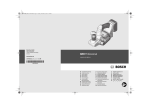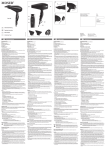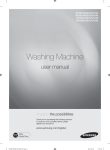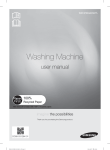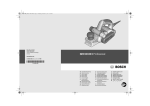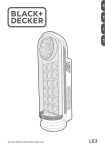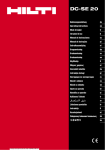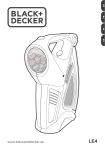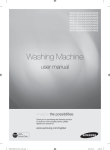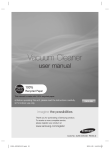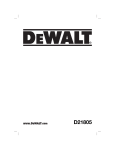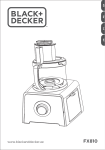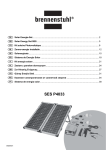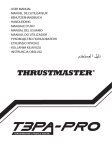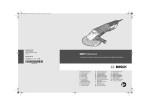Download Page 01 to 07 (STGL2018,STGL2218 IM) - Servis
Transcript
STGL2018 STGL2218 English French ﺍﻟﻌﺮﺑﻴﺔ Page 5 Page 14 Page 27 ENGLISH (Original instructions) 2 1 4 3 FIG A 3 6 20 7 5 FIG B 2 FIG C1 (Original instructions) 10 ENGLISH 10 8 8 6 7 9 6 7 10 8 6 7 FIG C2 10 FIG C3 3 90o 11 10 4 FIG D FIG E 3 ENGLISH (Original instructions) 15o-30o FIG F FIG G 4 A B (Original instructions) Specifications Input voltage ENGLISH Save all warnings and instructions for future reference VAC STGL2018 STGL2218 220-240 220-240 Power input W 2000 2200 Frequency Hz 50/60 50/60 No-load speed min-1 8500 8500 Wheel diameter mm 180 180 M14 M14 Spindle size Max disc thickness Grinding discs mm 6.6 6.6 Weight kg 4.9 5.9 Definitions: Safety Guidelines The definitions below describe the level of severity for each signal word. Please read the manual and pay attention to these symbols. Danger: Indicates an imminently hazardous situation which, if not avoided, will result in death or serious injury. Warning: Indicates a potentially hazardous situation which, if not avoided, could result in death or serious injury. Caution: Indicates a potentially hazardous situation which, if not avoided, may result in minor or moderate injury. Notice: Indicates a practice not related to personal injury which, if not avoided, may result in property damage. Denotes risk of electric shock. Denotes risk of fire. Warning: To reduce the risk of injury, read the instruction manual. The term “power tool” in the warnings refers to your mains-operated (corded) power tool or battery-operated (cordless) power tool. 1) Work area safety a) Keep work area clean and well lit. Cluttered or dark areas invite accidents. b) Do not operate power tools in explosive atmospheres, such as in the presence of flammable liquids, gases or dust. Power tools create sparks which may ignite the dust or fumes. c) Keep children and bystanders away while operating a power tool. Distractions can cause you to lose control. 2) Electrical safety a) Power tool plugs must match the outlet. Never modify the plug in any way. Do not use any adapter plugs with earthed (grounded) power tools. Unmodified plugs and matching outlets will reduce risk of electric shock. b) Avoid body contact with earthed or grounded surfaces such as pipes, radiators, ranges and refrigerators. There is an increased risk of electric shock if your body is earthed or grounded. c) Do not expose power tools to rain or wet conditions. Water entering a power tool will increase the risk of electric shock. d) Do not abuse the cord. Never use the cord for carrying, pulling or unplugging the power tool. Keep cord away from heat, oil, sharp edges or moving parts. Damaged or entangled cords increase the risk of electric shock. e) When operating a power tool outdoors, use an extension cord suitable for outdoor use. Use of a cord suitable for outdoor use reduces the risk of electric shock. f) If operating a power tool in a damp location is unavoidable, use a residual current device (RCD) protected supply. Use of an RCD reduces the risk of electric shock. General power tool safety warnings 3) Personal safety Warning! Read all safety warnings and all instructions. Failure to follow the warnings and instructions may result in electric shock, fire and/or serious injury. a) Stay alert, watch what you are doing and use common sense when operating a power tool. Do not use a power tool while you are tired or under the influence of drugs, alcohol or medication. A moment of inattention while operating power tools may result in serious personal injury. 5 ENGLISH (Original instructions) b) Use personal protective equipment. Always wear eye protection. Protective equipment such as dust mask, non-skid safety shoes, hard hat, or hearing protection used for appropriate conditions will reduce personal injuries. c) Prevent unintentional starting. Ensure the switch is in the off position before connecting to power source and/or battery pack, picking up or carrying the tool. Carrying power tools with your finger on the switch or energising power tools that have the switch on invites accidents. d) Remove any adjusting key or wrench before turning the power tool on. A wrench or a key left attached to a rotating part of the power tool may result in personal injury. e) Do not overreach. Keep proper footing and balance at all times. This enables better control of the power tool in unexpected situations. f) Dress properly. Do not wear loose clothing or jewellery. Keep your hair, clothing and gloves away from moving parts. Loose clothes, jewellery or long hair can be caught in moving parts. g) If devices are provided for the connection of dust extraction and collection facilities, ensure these are connected and properly used. Use of dust collection can reduce dust-related hazards. 4) Power tool use and care a) Do not force the power tool. Use the correct power tool for your application. The correct power tool will do the job better and safer at the rate for which it was designed. b) Do not use the power tool if the switch does not turn it on and off. Any power tool that cannot be controlled with the switch is dangerous and must be repaired. c) Disconnect the plug from the power source and/or the battery pack from the power tool before making any adjustments, changing accessories, or storing power tools. Such preventive safety measures reduce the risk of starting the power tool accidentally. d) Store idle power tools out of the reach of children and do not allow persons unfamiliar with the power tool or these instructions to operate the power tool. Power tools are dangerous in the hands of untrained users. e) Maintain power tools. Check for misalignment or binding of moving parts, breakage of parts and any 6 other condition that may affect the power tool’s operation. If damaged, have the power tool repaired before use. Many accidents are caused by poorly maintained power tools. f) Keep cutting tools sharp and clean. Properly maintained cutting tools with sharp cutting edges are less likely to bind and are easier to control. g) Use the power tool, accessories and tool bits etc., in accordance with these instructions taking into account the working conditions and the work to be performed. Use of the power tool for operations different from those intended could result in a hazardous situation. 5) Service a) Have your power tool serviced by a qualified repair person using only identical replacement parts. This will ensure that the safety of the power tool is maintained. Additional specific safety rules Safety instructions for all operations Safety warnings common for grinding a) This power tool is intended to function as a grinder. Read all safety warnings, instructions, illustrations and specifications provided with this power tool. Failure to follow all instructions listed below may result in electric shock, fire and/or serious injury. b) Operations such as cutting-off , sander, wire brush or polisher are not recommended to be performed with this power tool. Operations for which the power tool was not designed may create a hazard and cause personal injury. c) Do not use accessories which are not specifically designed and recommended by the tool manufacturer. Just because the accessory can be attached to your power tool, it does not assure safe operation. d) The rated speed of the accessory must be at least equal to the maximum speed marked on the power tool. Accessories running faster than their rated speed can break and fly apart. e) The outside diameter and the thickness of your accessory must be within the capacity rating of your power tool. Incorrectly sized accessories cannon be adequately guarded or controlled. (Original instructions) f) The arbour size of wheels, flanges, backing pads or any other accessory must properly fit the spindle of the power tool. Accessories with arbour holes that do not match the mounting hardware of the power tool will run out of balance, vibrate excessively and may cause loss of control. g) Do not use a damaged accessory. Before each use inspect the accessory such as abrasive wheel for chips and cracks, backing pad for cracks, tear or excess wear, wire brush for loose or cracked wires. If power tool or accessory is dropped, inspect for damage or install an undamaged accessory. After inspecting and installing an accessory, position yourself and bystanders away from the plane of the rotating accessory and run the power tool at maximum no-load speed for one minute. Damaged accessories will normally break apart during this test time. h) Wear personal protective equipment. Depending on application, use face shield, safety goggles or safety glasses. As appropriate, wear dust mask, hearing protectors, gloves and workshop apron capable of stopping small abrasive or workpiece fragments. The eye protection must be capable of stopping flying debris generated by various operations. The dust mask or respirator must be capable of filtrating particles generated by your operation. Prolonged exposure to high intensity noise may cause hearing loss. i) Keep bystanders a safe distance away from work area. Anyone entering the work area must wear personal protective equipment. Fragments of workpiece or of a broken accessory may fly away and cause injury beyond immediate area of operation. j) Hold the power tool by insulated gripping surfaces only, when performing an operation where the cutting accessory may contact hidden wiring or its own cord. Cutting accessory contacting a “live” wire may make exposed metal parts of the power tool “live” and could give the operator an electric shock. k) Position the cord clear of the spinning accessory. If you lose control, the cord may be cut or snagged and your hand or arm may be pulled into the spinning accessory. l) Never lay the power tool down until the accessory has come to a complete stop. The spinning accessory may grab the surface and pull the power tool out of your control. m) Do not run the power tool while carrying it at your side. Accidental contact with the spinning accessory ENGLISH could snag your clothing, pulling the accessory into your body. n) Regularly clean the power tool’s air vents. The motor’s fan will draw the dust inside the housing and excessive accumulation of powdered metal may cause electrical hazards. o) Do not operate the power tool near flammable materials. Sparks could ignite these materials. p) Do not use accessories that require liquid coolants. Using water or other liquid coolants may result in electrocution or shock. Further safety instructions for all operations Kickback and Related Warnings Kickback is a sudden reaction to a pinched or snagged rotating wheel, backing pad, brush or any other accessory. Pinching or snagging causes rapid stalling of the rotating accessory which in turn causes the uncontrolled power tool to be forced in the direction opposite of the accessory’s rotation at the point of the binding. For example, if an abrasive wheel is snagged or pinched by the workpiece, the edge of the wheel that is entering into the pinch point can dig into the surface of the material causing the wheel to climb out or kick out. The wheel may either jump toward or away from the operator, depending on direction of the wheel’s movement at the point of pinching. Abrasive wheels may also break under these conditions. Kickback is the result of tool misuse and/or incorrect operating procedures or conditions and can be avoided by taking proper precautions as given below: a) Maintain a firm grip on the power tool and position your body and arm to allow you to resist kickback forces. Always use auxiliary handle, if provided, for maximum control over kickback or torque reaction during start up. The operator can control torque reaction or kickback forces, if proper precautions are taken. b) Never place your hand near the rotating accessory. Accessory may kickback over your hand. c) Do not position your body in the area where power tool will move if kickback occurs. Kickback will propel the tool in direction opposite to the wheel’s movement at the point of snagging. d) Use special care when working corners, sharp edges etc. Avoid bouncing and snagging the accessory. Corners, sharp edges or bouncing have a tendency to snag the rotating accessory and cause loss of control or kickback. 7 ENGLISH (Original instructions) e) Do not attach a saw chain woodcarving blade or toothed saw blade. Such blades create frequent kickback and loss of control. Labels on tool The label on your tool may include the following symbols: Safety Warnings Specific for Grinding Operations Read Instructions Manual Use Eye Protection a) Use only wheel types that are recommended for your power tool and the specific guard designed for the selected wheel. Wheels for which the power tool was not designed cannot be adequately guarded and are unsafe. b) The guard must be securely attached to the power tool and positioned for maximum safety, so the least amount of wheel is exposed towards the operator. The guard helps to protect operator from broken wheel fragments and accidental contact with wheel and sparks that could ignite clothing. c) Wheels must be used only for recommended applications. For example: do not grind with the side of cut-off wheel. Abrasive cut-off wheels are intended for peripheral grinding, side forces applied to these wheels may cause them to shatter. d) Always use undamaged wheel flanges that are of correct size and shape for your selected wheel. Proper wheel flanges support the wheel thus reducing the possibility of wheel breakage. Flanges for cut-off wheels may be different from grinding wheel flanges. e) Do not use worn down wheels from larger power tools. Wheel intended for larger power tool is not suitable for the higher speed of a smaller tool and may burst. Residual Risks In spite of the application of the relevant safety regulations and the implementation of safety devices, certain residual risks cannot be avoided. These are: – Impairment of hearing – Risk of personal injury due flying particles. – Risk of burns due to accessories becoming hot during operation. min ..... minutes ..... Alternating Current Use Ear Protection V ........ Volts A ........ Amperes ..... Direct Current ...... Class II Construction .... Earthing Terminal .... Safety Alert Symbol .../min.. Revolutions or Reciprocation per minute n 0 ....... No-Load Speed Position of date barcode The Date Code, which also includes the year of manufacture, is printed into the housing. Example: 2014 XX JN Year of manufacturing Package Content This product package includes: 1 Angle grinder 1 Guard 1 Flange set 1 Spanner 1 Handle 1 Instruction manual • Check the tool, parts, and accessories to see if they are damaged during transportation. • Take a few moments to read and understand this manual before using the tool. Description (Fig. 1) Warning: Never modify the power tool or any part of the tool, otherwise it may cause damage to the tool or result in personal injury. – Risk of personal injury due to prolonged use. a. ON/OFF switch – Risk of dust from hazardous substances. b. Spindle lock c. Guard 8 Hz ....... Hertz W ........ Watts (Original instructions) ENGLISH Purpose of design Attaching the guard This angle grinder is designed especially for grinding. 1. Place the angle grinder on a work bench, groove facing up. Do not use sandpaper discs and grinding wheels other than those with depressed center. Do not use the tool in wet conditions or environments in the presence of flammable liquids or gases. 2. Bring the flange of the guard (3) collar over the groove (11) of the gear housing. 3. Turn the guard (4) counterclockwise by 150 degrees. This heavy-duty angle grinder is a professional power tool. 4. Make sure that the screws (20) are tightened. Do not allow children to come in contact with this tool. Inexperienced operators are required to use this tool under supervision. Removing the guard Electrical Equipment Safety 2. Pull up the guard (3). Only one voltage is applicable to this tool. Be sure to check that the power suuply corresponds to the voltage on the rating plate. Your STANLEY tool is equipped with double insulation, hence, it does not require to be earthed. When the power cord is damaged, have it sent to a STANLEY service center for replacement to specially prepared cables. Using Extension Cords If an extension cord is required, please select a 3-phase extension cord that has been inspected and matches the input power (see Technical Data) of this tool. The minimum conductor size is 1.5mm2, maximum length is 30 meters. When using a cable reel, be sure to pull out all the cables. Assembly and Adjustment Warning: To minimize the danger of serious personal injury, please switch off the tool power and disconnect all plugs before adjusting or removing/installing any accessory. Before reassembling the tool, press and release the trigger switch to make sure the tool is already switched off. Attaching and Removing the Wheel Guard (Fig. B) Warning To minimize the danger of serious personal injury, please switch off the tool power and disconnect all plugs before adjusting or removing/installing any accessory. Before reassembling the tool, press and release the trigger switch to make sure the tool is already switched off. 1. Loosen the screws (20) on the guard collar. Warning: Do not operate the tool when the safety guard is not in place. Fitting and removing a grinding (Fig. C1, C2, C3) Warning: Do not use damaged grinding wheels. 1. Place the tool on a work bench, guard up. 2. Fit the inner flange (6) correctly onto the spindle (7) (Fig. C1). 3. Place the disc (8) on the flange (6) (Fig.C2). When fitting a disc with a raised center, make sure that the raised centre (9) is facing the flange (6). 4. Screw the out flange (10) onto the spindle (7) (Fig. C3) - the ring on the flange (10) must fae towoards the disc when fitting a grinding disc (A) - the ring on the flange (10) must face away from the disc when fitting a cutting disc (B) 5. Press the spindle lock (2) and rotate the spindle (7) until it locks in position (Fig. C2). 6. Tighten the flange (10) with the two-pin spanner supplied. 7. Release the spindle lock. 8. To remove the disc, loosen the flange (10) with the two-pin spanner. Warning: Do not use a damaged disc. 9 ENGLISH (Original instructions) Mounting the side handle (Fig.D) • For grinding, screw the side handle (4) tightly into one of the holes (11) or (12) on either side of the gear case. Preparation Before Use • Attach the safety guard and appropriate abrasive or grinding wheels. Do not use abrasive or grinding wheels that are overly worn. • Make sure that the inner and outer flanges are attached correctly. • Make sure that the abrasive or grinding wheels are rotating in the direction of the arrows on the accessories and tool. Operation (Fig. F) Instructions Warning: Always observe the safety instructions and applicable regulations. Warning: To minimize the danger of serious personal injury, please switch off the tool power and disconnect all plugs before adjusting or removing/installing any accessory. Before reassembling the tool, press and release the trigger switch to make sure the tool is already switched off. Warning: • Make sure all materials to be grinded are secured in position. • Apply slight pressure to the tool. Do not apply side pressure to the abrasive disc. • Avoid overloading. If the tool becomes hot, let it spin for a few minutes with no load. 1. Be sure to hold the tool tightly with both hands (one hand on housing, the other on side handle). Start the tool and bring the grinding wheel on the workpiece. 2. Keep the edge of the wheel tilted at angle from 15 to 30 degrees against the surface of the workpiece. 3. When using a new grinding wheel, do not operate the wheel in the B direction, otherwise, it will cut into the workpiece. When the edge of wheel has been rounded off, you are free to operate the grinder in either the A or B direction. 10 Starting and Stopping (Fig. A) Warning: Before using the tool, check whether the handle is tightened securely. Check whether the ON/OFF switch is working normally. Before plugging in the tool to the power supply, check whether the switch is in the OFF position when pressing the rear end of the switch. To start the tool, press the rear end of the switch and slide it forward. Then press the front end of the switch to lock it. Press the rear end of the switch to stop the tool. Warning: Do not switch the tool on or off while under load conditions. Proper Hand Position (Fig. G) Warning: To reduce the risk of serious personal injury, ALWAYS use proper hand position as shown. Warning: To reduce the risk of serious personal injury, ALWAYS hold securely in anticipation of a sudden reaction. Proper hand position requires one hand on the side handle (figure A), with the other hand on the body of the tool, as shown in figure G. Switches Caution: Hold the body of the tool firmly to maintain control of the tool at start up and during use and until the wheel or accessory stops rotating. Make sure the wheel has come to a complete stop be fore laying the tool down. Note: To reduce unexpected tool movement, do not switch the tool on or off while under load conditions. Allow the grinder to run up to full speed before touching the work surface. Lift the tool from the surface before turning the tool off. Allow the tool to stop rotating before putting it down. ON/OFF switch (1) with auto-lock(Fig. A) Warning: Before connecting the tool to a power supply, be sure the slider switch is in the off position by pressing the front part of the switch and releasing. Ensure the slider switch is in the off position as described above after any interruption in power supply to the tool, such as the activation of a ground fault interrupter, throwing of a circuit breaker, accidental unplugging, or power failure. If the slider switch is locked on when the power is connected, the tool will start unexpectedly. (Original instructions) ENGLISH To start the tool, slide the slider switch 1 toward the front of the tool and press, the tool will keep running. Release pressure from the switch and the tool will stop. To avoid accumulation of metal chips in the interior of the grinder, we recommend cleaning the ventilation ducts daily. Refer to Maintenance. Lock feature of the ON/OFF switch Using Grinding Wheels Slide slider switch 1 to the front of the tool and press, and the tool will start. When releasing the switch, keep the switch pressed down and push it to the front of the tool, and the tool will keep running. To turn off the tool, press the front portion of the switch to release it. The switch will spring up, which means that the tool is in the off-state. Warning: Metal powder accumulates. Excessive use of the grinding wheel on metals may increase the risk of electric shock. To reduce the risk, insert the RCD before use and clean the ventilation ducts daily. Follow the maintenance instructions below to blow dry compressed air into the ventilation ducts. Explanation: Before coming into contact with the object you are working on, make sure the abrasive wheel is turning at maximum speed. Before turning off the tool, lift the tool up from the object you are working on. Maintenance Caution: Make sure the abrasive wheel is completely stopped before putting down the tool. Rotating the Gear Case (fig. E) The gear case is mounted onto the tool casing, and it can be rotated to give the user a more comfortable experience while cutting. The rotating gear case can be turned 90 degrees, 180 degrees, and 270 degrees to the left or to the right. STANLEY power tools have been designed to operate over a long period of time with minimal maintenance. Continuous satisfactory operation depends upon proper tool care and regular cleaning. Warning: To minimize the danger of serious personal injury, please switch off the tool power and disconnect all plugs before adjusting or removing/installing any accessory. Before reassembling the tool, press and release the trigger switch to make sure the tool is already switched off. • Loosen the four screws on the gear case. • Rotate the gear case till it reaches its ideal location. Lubrication • Tighten the four screws on the gear case. This power tool does not require separate lubrication. • Ensure that the rotating mechanism is locked. Warning: Do NOT use the tool when the gear case is unlocked. Application on Metals When applying the tool on metals, make sure that a residual-current device (RCD) is inserted to prevent danger from metal chips. If the RCD causes power disconnection, have the tool sent to an authorized STANLEY dealer for repair. Warning: Under extreme working conditions, conductive dust and grit may accumulate on the housing interior when handling metal workpieces. This could create an electric shock hazard as it weakens the protective insulation in the grinder. Cleaning Warning: Once visible dust accumulates on the ventilation ducts and the surrounding, immediately use dry air to blow away dust and grit out of the interior of the housing. You need to wear approved eye and facial protective gear when performing this process. Warning: Never use solvents or harsh chemicals to clean non-metal parts of the tool. These chemicals may weaken the material of the parts. Use only mild soap and damp cloth to clean the tool. Never let any liquid get inside the tool; never immerse any part of the tool into liquid. 11 ENGLISH (Original instructions) Accessories Warning: Excluding accessories provided by STANLEY, all other accessories have not been tested for product compatibility. Using such accessories together with this tool may cause safety hazards. To minimize the risk of personal injury, we recommend you to use only STANLEY accessories with this product. Please inquire at your dealer for more information regarding suitable accessories. Remarks • STANLEY's policy is one of continuous improvement to our products and as such, we reserve the right to modify product specifications without prior notice. • Standard equipment and accessories may vary by country. • Product specifications may differ by country. • Complete product range may not be available in all countries. Contact your local STANLEY dealers for range availability. 12 Protecting the environment Separate collection. This product must not be disposed of with normal household waste. Should you find one day that your STANLEY product needs replacement, or if it is of no further use to you, do not dispose of it with household waste. Make this product available for separate collection. Separate collection of used products and packaging allows materials to be recycled and used again. Re-use of recycled materials helps prevent environmental pollution and reduces the demand for raw materials. Local regulations may provide for separate collection of electrical products from the household, at municipal waste sites or by the retailer when you purchase a new product. STANLEY provides a facility for the collection and recycling of STANLEY products once they have reached the end of their working life. To take advantage of this service please return your product to any authorised repair agent who will collect them on our behalf. You can check the location of your nearest authorised repair agent by contacting your local Stanley office at the address indicated in this manual. Alternatively, a list of authorised STANLEY repair agents and full details of our after-sales service and contacts are available on the Internet at: www.2helpU.com (Original instructions) ENGLISH One year warranty If your STANLEY product becomes defective due to faulty materials or workmanship within 12 months from the date of purchase, STANLEY Europe guarantees to replace all defective parts free of charge or – at our discretion – replace the unit free of charge provided that: • The product has not been misused and has been used in accordance with the instruction manual. • The product has been subject to fair wear and tear; • Repairs have not been attempted by unauthorised persons; • Proof of purchase is produced. • The STANLEY product is returned complete with all original components If you wish to make a claim, contact your seller or check the location of your nearest authorised STANLEY repair agent in the STANLEY catalogue or contact your local STANLEY office at the address indicated in this manual. A list of authorised STANLEY repair agents and full details of our after sales service is available on the internet at:www.stanleytools.com 13 FRANÇAIS (Original instructions) Spécifications STGL2018 STGL2218 Tension d’entrée Puissance Fréquence W 2000 2200 La notion "d’outil électroportatif" mentionnée par la suite se rapporte à des outils électriques raccordés au secteur (avec câble) ou fonctionnant avec piles (sans fil). 1. Sécurité de la zone de travail VAC 220-240 220-240 Hz 50/60 50/60 Aucune vitesse de charge min-1 8500 8500 Diamètre du disque mm 180 180 M14 M14 Epaisseur du disque de meulage mm 6.6 6.6 Poids 4.9 5.9 Diamètre de l’axe Épaisseur du disque Max kg Définitions: Consignes de sécurité Les définitions données ci-dessous décrivent le niveau de gravité pour chaque symbole. Veuillez lire ce manuel et prêter attention à ces symboles. Danger: Indique une situation extrêmement dangereuse qui, si elle n’est pas évitée, aura pour conséquence des blessures corporelles graves ou mortelles. Attention: Indique une situation potentiellement dangereuse qui, si elle n’est pas évitée, aura pour conséquence des blessures corporelles graves ou mortelles. Avertissement: Indique une situation potentiellement dangereuse qui, si elle n’est pas évitée, aura pour conséquence des blessures corporelles légères ou de gravité modérée. Avis: Indique une pratique non reliée à des blessures corporelles qui, si elle n’est pas évitée, aura pour conséquence des dommages matériels. Indique un risque de choc électrique. Indique un risque d’incendie. Attention: Pour réduire le risque de blessures corporelles, lire ce manuel d’instructions. Consignes générales de sécurité concernant les outils électroportatifs Attention! Lire avec attention tous les avertissements et toutes les instructions. Le non-respect des avertissements et des instructions indiquées ci-dessous peut entraîner un choc électrique, un incendie et/ou des blessures graves 14 Conservez ces consignes et ces instructions pour référence ultérieure. a. Maintenir la zone de travail propre et bien éclairée. Un lieu de travail en désordre ou mal éclairé augmente le risque d’accidents. b. Ne pas utiliser d’outils électroportatifs dans un environnement présentant des risques d’explosion ni en présence de liquides, gaz ou poussières inflammables. Les outils électroportatifs génèrent des étincelles risquant d’enflammer les poussières ou les vapeurs. c. Pendant l’utilisation d’un outil électroportatif, les enfants et autres personnes présentes doivent rester éloignés. En cas d’inattention, vous risquez de perdre le contrôle de l’outil. 2. Sécurité électrique a. La fiche de l’outil électrique doit être compatible avec la prise d’alimentation, Ne modifiez la fiche en aucun cas. N’utilisez pas d’adaptateurs avec des outils ayant une prise de terre. Le respect de ces consignes réduit le risque de choc électrique. b. Eviter le contact physique avec des surfaces mises à la terre telles que tuyaux, radiateurs, fours et réfrigérateurs. Le risque de choc électrique augmente si votre corps est relié à la terre. c. Ne pas exposer les outils électroportatifs à la pluie ou à l’humidité. La pénétration d’eau dans un outil électroportatif augmente le risque de choc électrique. d. Ne pas maltraiter le câble d’alimentation. Ne jamais utiliser le câble pour porter l’outil, et ne le tirez pas pour débrancher l’outil. Maintenir le câble éloigné des sources de chaleur, de la graisse, des bords coupants et des pièces en rotation. Un câble endommagé ou emmêlé augmente le risque de choc électrique. e. Lorsque vous utilisez l’outil électroportatif à l’extérieur, utilisez une rallonge homologuée pour une utilisation à l’extérieur. L’utilisation d’une rallonge électrique homologuée pour les travaux à l’extérieur réduit le risque de choc électrique. f. Si l’outil doit être utilisé dans un endroit humide, utilisez un dispositif différentiel à courant résiduel (DDR). L’utilisation d’un tel dispositif réduit le risque de choc électrique. (Original instructions) 3. Sécurité personnelle a. Restez vigilant, surveillez ce que vous faites et faites preuve de bon sens quand vous utilisez un outil. N’utilisez pas un outil électroportatif lorsque vous êtes fatigué ou après avoir consommé de l’alcool ou pris des médicaments. Un moment d’inattention en utilisant l’outil peut entraîner de graves blessures. b. Portez un équipement de protection. Portez toujours des lunettes de protection. Selon le travail à effectuer, le port d’un équipement de protection tel que masque anti-poussières, chaussures de sécurité antidérapantes, casque ou protection auditive, réduit le risque de blessures. FRANÇAIS électroportatifs sont dangereux lorsqu’ils sont utilisés par des personnes non initiées. e. Entretenez les outils électroportatifs. Vérifiez que les parties en mouvement fonctionnent correctement et qu’elles ne sont pas coincées. Vérifiez qu’il n’y a pas de pièces cassées ou endommagées susceptibles de nuire au bon fonctionnement de l’outil. S’il est endommagé, faites réparer l’outil avant de l’utiliser. De nombreux accidents sont la conséquence d’outils mal entretenus. f. Les outils de coupe doivent toujours être aiguisés et propres. Des outils soigneusement entretenus avec des bords tranchants bien aiguisés se coincent moins souvent et peuvent être guidés plus facilement. c. Evitez tout démarrage imprévu. L’interrupteur de l’outil doit être en position d’arrêt (off) avant d’effectuer le branchement à l’alimentation et/ou au bloc batterie, de ramasser l’outil ou de le porter. Porter ou brancher un outil électrique dont l’interrupteur est en position Marche (on) est une invite à l’accident. g. Utilisez l’outil électroportatif, les accessoires et les forets, etc., conformément à ces instructions, en tenant compte des conditions de travail et des tâches à effectuer. L'utilisation des outils électroportatifs à d’autres fins que celles prévues peut entrainer des situations dangereuses d. Retirez les outils ou les clés de réglage avant de mettre l’outil en marche. Une clé ou un outil se trouvant sur une partie en rotation peut causer des blessures. 5. Réparations e. Adoptez une position confortable. Adoptez une position stable et gardez votre équilibre en permanence. Vous contrôlerez mieux l’outil dans des situations inattendues. f. Portez des vêtements appropriés. Ne portez pas de vêtements amples ou de bijoux. N’approchez pas les cheveux, vêtements ou gants des pièces en mouvement. Les vêtements amples, les bijoux ou les cheveux longs peuvent s’accrocher dans les pièces en mouvement. g. En cas d’utilisation d’appareils servant à aspirer ou à recueillir les poussières, assurez-vous qu’ils sont correctement raccordés et utilisés. L’utilisation de tels dispositifs réduit les dangers dus aux poussières. a. Faites réparer votre outil électroportatif uniquement par du personnel qualifié et seulement avec des pièces de rechange appropriées. Cela garantira le maintien de la sécurité de votre outil. Consignes de sécurité spécifiques supplémentaires Consignes de sécurité pour l’ensemble des opérations Conseils de sécurité courants pour le meulage a) Cet outil électroportatif est conçu pour être utilisé comme meuleuse. Lire avec attention tous les avertissements, les instructions, les illustrations et les spécifications données avec cet outil. Le anon-respect des instructions indiquées ci-dessous peut entraîner un choc électrique, un incendie et/ou de graves blessures. a. Respectez la capacité de l’outil. Utilisez l’outil approprié pour le travail à effectuer. Avec un outil approprié, vous travaillerez mieux et en toute sécurité. b) Cet outil n’est pas recommandé pour des opérations telles que scier, poncer, nettoyer avec une brosse métallique ou polir. L’utilisation à d’autres fins que celles prévues présente un danger et peut causer des blessures graves. b. N’utilisez pas un outil électroportatif dont l’interrupteur marche/arrêt est défectueux. Un outil électroportatif qui ne répond pas à la commande marche/arrêt est dangereux et doit être réparé. c) Seuls les accessoires spécialement conçus et recommandés par le fabricant doivent être utilisés. Même si un accessoire peut être fixé à l’outil, cela ne signifie pas que votre outil fonctionnera en toute sécurité. c. Retirez la fiche de la prise de courant et/ou débranchez le bloc-batterie avant d’effectuer des réglages, de changer les accessoires ou de ranger l’outil. Cette mesure de précaution empêche de mettre l’outil en marche accidentellement. d) La vitesse nominale doit être au moins égale à la vitesse maximale inscrite sur l’outil. Les accessoires dont la rotation est plus rapide que leur vitesse nominale peuvent se briser et éclater en plusieurs morceaux. 4. Utilisation des outils électroportatifs et précautions d. Rangez les outils électroportatifs hors de la portée des enfants et les personnes ne connaissant pas l’outil ne doivent en aucun cas l’utiliser. Les outils e) Le diamètre extérieur et l’épaisseur de votre accessoire doivent correspondre à la capacité nominale de votre outil électroportatif. Il est impossible de garantir la protection ou le contrôle des accessoires de dimension incorrecte. 15 FRANÇAIS (Original instructions) f) La dimension de l’alésage central des disques, des flasques, du plateau porte-disques ou d’autres accessoires doit correspondre exactement à l’axe de l’outil. Les accessoires dont l’alésage central ne correspond pas au matériel de fixation de l’outil peuvent être difficiles à contrôler. Le niveau de vibrations peut augmenter et provoquer la perte du contrôle de l’outil. g) N’utilisez pas d’accessoires endommagés. Avant toute utilisation, vérifiez l’état de tous les accessoires, la présence d’éclats ou de fissures sur les disques polisseurs, de fissures ou une usure excessive sur le plateau porte-disques, de poils de brosse métallique endommagés. Si l’outil ou l’accessoire tombe, vérifiez leur état et le cas échéant, installez un accessoire en bon état. Apres inspection et l’installation d’un accessoire, tenez-vous, ainsi que toute personne présente, hors du plan de rotation de l’accessoire et laissez tournez l’outil pendant une minute à sa vitesse à vide maximale. En général, tout accessoire endommagé se brisera lors du temps d’essai. h) Portez un équipement de protection. En fonction du travail à effectuer, utilisez un masque ou des lunettes de protection. Le cas échéant, portez un masque anti-poussières, des protections auditives, des gants et un tablier de travail afin de vous protéger des éventuels éclats. En protégeant vos yeux, vous éviterez les éclats créés pendant le travail. En portant un masque anti-poussières, vous éviterez de respirer les particules créées pendant le travail. Une exposition prolongée aux bruits trop puissants peut entraîner la perte de l’ouïe. i) Pour le maintien de la sécurité, éloignez les personnes autour de la zone de travail. Toute personne entrant dans la zone de travail doit porter un équipement de protection. Des éclats de la pièce usinée ou d’un accessoire cassé peuvent être projetés au-delà de la zone de travail et causer des blessures. j) Tenez l’outil uniquement au niveau des surfaces isolées, lorsque vous effectuer un travail qui pourrait mettre l’outil de coupe en contact avec des fils cachés ou son propre câble. En touchant un fil sous tension, la charge électrique passe dans les parties métalliques de l’outil électroportatif et il y a risque de choc électrique. k) Eloignez le câble des accessoires en rotation. Si vous perdez le contrôle, le câble peut être coupé ou s’accrocher et votre main ou votre bras peut se trouver entrainé dans l’accessoire en rotation. l) Ne posez jamais l’outil avant l’arrêt complet de l’accessoire. L’accessoire en rotation peut s’accrocher à la surface, ce qui vous ferait perdre le contrôle de l’outil. m) Ne mettez pas l’outil en marche lorsque vous le transportez. L’accessoire en rotation peut attraper vos vêtements et vous blesser. 16 n) Nettoyez régulièrement les fentes d’aération de l’outil. Le ventilateur du moteur entraîne la poussière à l’intérieur de l’outil et une accumulation excessive de la poudre de métal peut causer des accidents liés à l’électricité. o) Ne faites pas fonctionner l’outil à proximité de matières inflammables. Les étincelles risquent d’enflammer ces matières. p) N’utilisez pas d’accessoires nécessitant un liquide de refroidissement. L’utilisation d’eau ou d’un autre liquide de refroidissement peut entrainer un choc électrique ou une électrocution. Consignes de sécurité supplémentaires pour l’ensemble des opérations Effet de retour et avertissements L’effet de retour est une réaction soudaine d’un disque en rotation, d’un plateau porte-disques ou de tout autre accessoire coincé ou accroché. Ce genre de problème arrête rapidement l’accessoire de rotation. L’outil devient alors incontrôlable et est entraîné en direction inverse de la rotation. Par exemple, si un disque polisseur est accroché ou coincé par la pièce à usiner, le bord du disque qui se trouve au point de pincement peut creuser la surface du matériau, ce qui provoque une mauvaise rotation du disque. Le disque peut être éjecté vers l’utilisateur ou à l’opposé selon la direction du mouvement du disque au point de pincement. Les disques polisseurs peuvent aussi se casser dans ce type de situation. L’effet de retour est le résultat d’une utilisation inappropriée de l’outil voire de procédures ou de conditions d’utilisation incorrectes. Ceci peut être évité en appliquant les précautions adéquates, décrites ci-dessous: a. En maintenant fermement l’outil, placez votre corps et votre bras de manière à pouvoir résister à la puissance du moteur. Utilisez toujours la poignée auxiliaire lorsqu’elle est fournie, pour contrôler au maximum l’effet de retour ou la réaction de couple au démarrage. L’utilisateur peut contrôler les réactions de couple ou les forces de retour, si les précautions nécessaires sont prises. b. Ne placez jamais votre main à côté de l’accessoire en rotation. L’accessoire peut se retourner sur votre main. c. Ne vous placez pas dans la zone de déplacement de l’outil si un effet de retour se produit. L’effet de retour pousse l’outil dans la direction opposée au mouvement du disque au point d’accrochage. d. Prenez les précautions nécessaires pour travailler dans les coins, les arêtes vives, etc. Evitez de coincer ou de faire rebondir l’accessoire. Les coins, les arêtes vives ou les à-coups ont tendance à coincer l’accessoire en rotation et à causer la perte de contrôle ou un effet de retour. (Original instructions) e) Ne fixez pas une lame de sculpture ou une lame de scie dentée. Ce genre de lames crée fréquemment un effet de retour et la perte de contrôle. Etiquettes apposées sur l’outil L’étiquette apposée sur votre outil peut contenir les symboles suivants: Conseils de sécurité spécifiques pour les opérations de meulage a) N’utilisez que les types de disque recommandés pour votre outil et la protection spécifique au disque sélectionné. Les disques destinés à d’autres outils ne peuvent être protégés correctement et par conséquent sont dangereux b) La protection doit être correctement fixée à l’outil, en exposant le disque le moins possible vers l’utilisateur pour le protéger au maximum. La protection permet de protéger l’utilisateur des éclats, d’un contact accidentel avec le disque et des étincelles qui pourraient enflammer les vêtements. c) Les disques ne doivent être utilisés que pour les applications recommandées. Par exemple: ne meulez pas avec le côté du disque de coupe. Les disques abrasifs sont destinés au meulage périphérique, des forces latérales auraient pour conséquence de les briser. Lire le manuel d’instructions Hz ....... Hertz Utiliser une protection oculaire min ..... minutes V ........ Volts A ........ Ampères – Poussières contenant des substances nocives. .../min.. de sécurité Rotations par minute n 0 ....... Vitesse à vide La boîte de cet outil contient: 1 Carter de protection 1 Jeu de flasques 1 Clé 1 Manuel d’instructions • Contrôlez visuellement l’outil, les pièces et les accessoires pour vérifier qu’ils n’ont pas été endommagés pendant le transport. • Prenez quelques instants pour lire et assimiler les instructions données dans ce manuel avant d’utiliser cet outil. Risques résiduels – Blessures causées par l’utilisation prolongée d’un outil. .... ..... Courant continu Borne de terre Symbole d’alerte Contenu de la boîte 1 Poignée – Brûlures causées par les accessoires devenant chauds pendant l’utilisation. .... ..... Courtant alternatif Le code de la date, comprenant aussi l’année de fabrication, est imprimé sur le boîtier de l’outil. Exemple: 2014 XX JN Année de fabrication e) N’utilisez pas de disques usés pris sur des meuleuses plus grandes. Les disques destinés aux grandes meuleuses ne sont pas adaptés aux vitesses rapides des petites meuleuses et peuvent se décrocher. – Blessures causées par la projection d’éclats. ...... Construction de classe II Position of date barcode 1 Meuleuse d’angle – Troubles auditifs W ........ Watts Utiliser des protections auditives d) N’utilisez que des flasques en bon état, de dimension et de forme appropriées à votre disque. Les flasques de disque appropriés soutiennent le disque, ce qui limite le risque de casse. Les flasques des disques de coupe peuvent être différents de ceux des disques de meulage. Même en respectant les consignes de sécurité applicables et en utilisant des dispositifs de sécurité, certains risques résiduels ne peuvent pas être évités. Sont inclus: FRANÇAIS Description (Fig. 1) Attention: Ne modifiez jamais un outil électrique ou une partie de l’outil, cela pourrait l’endommager et entraîner des blessures corporelles. a. Interrupteur Marche/Arrêt b. Blocage de l’axe c. Carter de protection 17 FRANÇAIS (Original instructions) Objectif de conception Installation du carter de protection Cette meuleuse d’angle est conçue spécialement pour le meulage. 1. Placez la meuleuse d’angle sur un banc de travail, rainure vers le haut. N’utilisez pas de disques abrasifs ou de meulage autres que ceux dont le centre est incurvé. 2. Alignez le flasque de la collerette du carter (3) sur la rainure (11) du boîtier d’engrenage. N’utilisez pas l’outil dans un milieu humide ou à proximité de liquides ou de gaz inflammables. 3. Faites pivoter le carter (4) dans le sens antihoraire de 150 degrés. Cette meuleuse d’angle ultra robuste est un outil électrique professionnel. 4. Assurez-vous que les vis (20) sont serrées. Ne laissez pas les enfants manipuler cet outil. Les opérateurs inexpérimentés doivent être surveillés lorsqu’ils utilisent cet outil. 1. Desserrez les vis (20) sur la collerette du carter. Sécurité électrique des équipements Le moteur électrique a été conçu pour une tension spécifique. Vérifiez toujours que la tension secteur correspond à celle indiquée sur la plaque signalétique. Votre outil Stanley est doublement isolé et de ce fait, ne nécessite pas un branchement à la terre. Lorsque le câble d’alimentation est endommagé, envoyez-le dans un centre de réparations Stanley pour qu’il soit remplacé par un câble spécialement préparé. Utilisation d’un cordon prolongateur Si l’utilisation d’un cordon prolongateur est nécessaire, veuillez utiliser une rallonge à 3 phases qui a été vérifiée et dont la puissance nominale correspond à l’outil (voir Données techniques). La taille minimale du conducteur est de 1,5mm2 avec une longueur maximale de 30 mètres. Si vous utilisez un enrouleur de câble, déroulez toujours le câble entièrement. Assemblage et réglage Attention! Pour minimiser le risque de blessures corporelles graves, veuillez éteindre et débrancher toutes les fiches avant de régler ou d’enlever/ajouter un accessoire. Avant de remonter l’outil, appuyez sur le déclencheur puis relâchez-le pour vous assurer que l’outil est bien éteint. Installation et retrait du carter de protection (Fig. B) Attention! Pour minimiser le risque de blessures corporelles graves, veuillez éteindre et débrancher toutes les fiches avant de régler ou d’enlever/ajouter un accessoire. Avant de remonter l’outil, appuyez sur le déclencheur puis relâchez-le pour vous assurer que l’outil est bien éteint. 18 Retrait du carter de protection 2. Retirez le carter de protection (3). Attention! Ne faites pas fonctionner l’outil sans le carter de protection en place Installation et retrait du disque de meulage (Fig. C1, C2, C3) Attention! N’utilisez pas de disques de meulage endommagés. 1. Placez l’outil sur un banc de travail, carter de protection vers le haut. 2. Installez le flasque intérieur (6) correctement sur l’axe (7) (Fig. C1). 3. Placez le disque (8) sur le flasque (6) (Fig. C2). Lorsque vous installez un disque avec un centre relevé, assurez-vous que le centre relevé du disque (9) est orienté vers le flasque (6). 4. Vissez fermement le flasque extérieur (10) sur l’axe (7) (Fig. C3). - Lorsque vous installez un disque de meulage (A), l’anneau situé sur le flasque (10) doit être orienté vers le disque. - l’anneau sur le flasque (10) doit être orienté à l’opposé du disque lorsque vous installez un disque de coupe (B) 5. Maintenez le blocage de l’axe (2) enfoncé et faites pivoter l’axe (7) jusqu’à ce qu’il s’enclenche en position (Fig. C2). 6. Serrez le flasque (10) avec la clé à ergots fournie. 7. Relâchez le blocage de l’axe. 8. Pour retirer le disque, desserrez le flasque (10) avec la clé à deux ergots. (Original instructions) Attention! N’utilisez pas de disques endommagés. Installation de la poignée latérale (Fig.D) • Pour meuler, vissez fermement la poignée latérale (4) dans l’un des trous (11) ou (12) situés de chaque côté du boîtier d’engrenage. Préparation avant l’utilisation • Installez le carter de protection et les disques abrasifs ou de meulage appropriés. N’utilisez pas de disques abrasifs ou de meulage usés à l’excès. • Assurez-vous que les flasques intérieur et extérieur sont correctement installés. • Assurez-vous que les disques abrasifs ou de meulage tournent dans le sens des flèches présentes sur les accessoires et l’outil. Fonctionnement (Fig. F) Instructions fonctionner le disque dans la direction A ou B. Mise en marche et arrêt (Fig. A) Attention! Avant d’utiliser l’outil, vérifiez que la poignée est correctement serrée. Vérifiez que l’interrupteur Marche/Arrêt fonctionne normalement. Avant de brancher l’outil au secteur, vérifiez que l’interrupteur est bien en position Arrêt en appuyant sur l’extrémité arrière de l’interrupteur. Pour démarrer l’outil, appuyez sur l’extrémité arrière de l’interrupteur et faites-le glisser vers l’avant. Puis appuyez sur l’extrémité avant de l’interrupteur pour le verrouiller. Appuyez sur l’extrémité arrière de l’interrupteur pour arrêter l’outil. Attention! Ne mettez pas l’outil hors ou sous tension lorsqu’il est sous charge. Position correcte des mains (Fig. G) Attention! Pour réduire le risque de blessures corporelles graves, placez TOUJOURS vos mains correctement comme indiqué. Attention! Respectez toujours les consignes de sécurité et la réglementation en vigueur. Attention! Pour minimiser le risque de blessures corporelles graves, veuillez éteindre et débrancher toutes les fiches avant de régler ou d’enlever/ajouter un accessoire. Avant de remonter l’outil, appuyez sur le déclencheur puis relâchez-le pour vous assurer que l’outil est bien éteint. Attention: • Assurez-vous que tous les matériaux à meuler sont arrimés en place. • Appliquez une légère pression sur l’outil. N’exercez pas de pression latérale sur le disque de meulage. • Evitez de surcharger l’outil. Si l’outil devient chaud, laissez-le tourner à vide pendant quelques minutes. 1. Maintenez fermement l’outil avec vos deux mains (une main sur le boîtier, l’autre sur la poignée latérale). Mettez l’outil en marche et approchez le disque de la meuleuse sur la pièce à meuler. 2. Conservez un angle de 15 à 30 degrés entre le bord du disque et la surface de la pièce. 3. Lorsque vous utilisez un disque à meuler neuf, ne faites pas fonctionner le disque dans la direction B, sinon il risque de couper dans la pièce à meuler. Lorsque le bord du disque s’est arrondi, vous pouvez alors faire FRANÇAIS soudaine. Attention! Pour réduire le risque de blessures corporelles graves, maintenez TOUJOURS l’outil fermement en anticipation d’une réaction Une position correcte des mains demande une main sur la poignée latérale (figure A), et l’autre main sur le corps de l’outil, comme le montre la figure G. Interrupteurs Avertissement: Maintenez fermement le corps de l’outil pour en garder le contrôle au démarrage et pendant son utilisation, et jusqu’à l’arrêt du disque ou d’un accessoire. Veillez à attendre l’arrêt complet avant de reposer l’outil. Remarque: Pour réduire le risque d’un mouvement inattendu de l’outil, ne le mettez pas hors ou sous tension pendant qu’il est sous charge. Laissez la meuleuse atteindre sa pleine vitesse avant de toucher la surface à meuler. Soulevez l’outil de la pièce avant de l’éteindre. Attendre l’arrêt complet de l’outil avant de le poser. Interrupteur Marche/Arrêt (1) avec verrouillage automatique (Fig. A) Attention! Avant de brancher l’outil au secteur, vérifiez que l’interrupteur à glissière est bien en position arrêt en appuyant sur l’extrémité avant de l’interrupteur puis en le 19 FRANÇAIS (Original instructions) relâchant. Vérifiez que l’interrupteur à glissière est en position arrêt comme décrit ci-dessus après une interruption de l’alimentation électrique de l’outil, comme l’activation d’un détecteur de fuite à la terre, d’un coupe-circuit, un débranchement involontaire ou une panne électrique. Si l’interrupteur à glissière est bloqué lorsque l’outil est sous tension, l’outil peut redémarrer de manière inattendue. Pour démarrer l’outil, faites glisser l’interrupteur à glissière (1) vers l’avant de l’outil et appuyez dessus, l’outil fonctionnera en continu, relâchez la pression sur l’interrupteur pour arrêter l’outil. Fonction de verrouillage de l’interrupteur Marche/Arrêt Pour démarrer l’outil faites glisser l’interrupteur à glissière (1) vers l’avant de l’outil et appuyez dessus. Lorsque vous relâchez l’interrupteur, gardez-le enfoncé en le poussant vers l’avant et l’outil continuera de fonctionner. Pour éteindre l’outil, appuyez sur la partie avant de l’interrupteur pour le relâcher. L’interrupteur remonte ce qui indique que l’outil est en position arrêt. Explication: Laissez le disque abrasif arriver à sa vitesse maximale avant d’entrer en contact avec la pièce à usiner. Avant d’éteindre l’outil, soulevez d’abord le disque de la pièce à usiner. Avertissement: Attendre l’arrêt complet du disque avant de poser l’outil. Rotation du boîtier d’engrenage (fig. E) Le boîtier d’engrenage est monté sur le corps de l’outil et il peut être tourné pour donner plus de confort à l’utilisateur pendant une opération de coupe. Le boîtier d’engrenage rotatif peut être incliné de 90 degrés, 180 degrés, ou 270 degrés sur la gauche ou sur la droite. • Desserrer les quatre vis du boîtier d’engrenage. • Faire pivoter le boîtier d’engrenage jusqu’à la position idéale. • Serrer les quatre vis du boîtier d’engrenage. • Vérifier que le mécanisme de rotation est verrouillé. Attention: NE PAS utiliser l’outil lorsque le boîtier d’engrenage est déverrouillé. Meulage de métaux Lorsque vous meulez des métaux, assurez-vous que le dispositif de courant résiduel (RCD) est inséré pour éviter tout danger provenant des copeaux métalliques. 20 Si le RCD provoque la suppression de l’alimentation, faites réparer l’outil dans un centre de service agréé Stanley. Attention! Dans des conditions de travail extrêmes, la poussière et les salissures conductrices peuvent s’accumuler à l’intérieur du boîtier lorsque vous meulez des pièces métalliques. Cela pourrait créer un risque de choc électrique car l’isolation protectrice de la meuleuse en serait affaiblit. Pour éviter l’accumulation de copeaux métalliques à l’intérieur de la meuleuse, nous vous recommandons de nettoyer les orifices d’aération tous les jours. Reportez-vous au chapitre sur l’entretien. Utilisation des disques de meulage Attention : La poudre métallique s’accumule. Une utilisation excessive du disque de meulage sur métaux peut augmenter le risque de choc électrique. Pour réduire ce risque, insérez le RCD avant d’utiliser l’outil et nettoyez les aérations quotidiennement. Suivez les instructions d’entretien données ci-dessous pour souffler de l’air comprimé dans les orifices d’aération. Entretien Les outils électriques Stanley ont été conçus pour fonctionner sur une longue période de temps avec un minimum d’entretien. Un fonctionnement continu satisfaisant dépend d’un nettoyage et d’un entretien soigneux et régulier. Attention: Pour minimiser le risque de blessures corporelles graves, veuillez éteindre et débrancher toutes les fiches avant de régler ou d’enlever/ajouter un accessoire. Avant de remonter l’outil, appuyez sur le déclencheur puis relâchez-le pour vous assurer que l’outil est bien éteint Lubrification Cet outil électroportatif ne nécessite pas d’être lubrifié. Nettoyage Attention: Lorsque la poussière accumulée sur et autour des aérations est visible, utilisez immédiatement un souffleur d’air pour chasser la poussière et les salissures de l’intérieur du boîtier. Vous devez porter un équipement de protection approuvé pour les yeux et le visage pour effectuer ce processus de nettoyage. (Original instructions) FRANÇAIS Attention: N’utilisez jamais de solvants ou de produits chimiques agressifs pour nettoyer les parties non-métalliques de l’outil. Ces produits chimiques peuvent affaiblir le matériau ou les pièces. Utilisez seulement un détergent doux et un chiffon humide pour nettoyer cet outil. Ne laissez jamais de liquide pénétrer à l’intérieur de l’outil; n’immergez jamais une partie de l’outil dans un liquide. Les réglementations locales peuvent proposer la collecte sélective des appareils électriques ménagers, dans des déchetteries municipales ou par le revendeur lorsque vous achetez un nouvel appareil. Stanley dispose d’installations pour la collecte et le recyclage des produits Stanley en fin de vie. Pour profiter de ce service, veuillez rapporter votre appareil auprès d’un centre de réparation agréé qui se chargera de le collecter en notre nom. Accessoires Pour connaître l’adresse d’un centre de réparation agréé près de chez vous, contactez votre distributeur Stanley à l’adresse indiquée dans ce manuel, ou consultez la liste des centres de réparation agréés Stanley et tout renseignement complémentaire sur notre service après-vente sur le site internet à l’adresse: www.2helpU.com. Attention: A l’exception des accessoires fournis par Stanley, la compatibilité de tous les autres accessoires avec cet outil n’a pas été testée. L’utilisation de ce type d’accessoires avec cet outil peut entraîner un danger. Pour minimiser le risque de blessures corporelles, nous vous recommandons d’utiliser uniquement des accessoires Stanley avec cet outil. Pour plus de renseignements concernant les accessoires appropriés, prenez contact avec votre revendeur. Remarques • STANLEY mène une politique d’amélioration continue de ses produits et se réserve de ce fait, le droit d’en modifier les caractéristiques sans préavis. • Les équipements d’origine et les accessoires peuvent varier d’un pays à l’autre. • Les caractéristiques d’un produit peuvent varier d’un pays à l’autre. • La gamme complète des produits peut ne pas être offerte dans tous les pays. Contactez votre revendeur STANLEY pour connaître la disponibilité de la gamme. Protection de l’environnement Collecte sélective. Ne pas jeter cet appareil avec les ordures ménagères. Si vous devez remplacer un appareil Stanley ou si vous ne l’utilisez plus, ne le jetez pas avec les ordures ménagères, mais dans les conteneurs de collecte sélective. La collecte sélective des produits et des emballages usagés permet de recycler et de réutiliser leurs matériaux. La réutilisation de matériaux recyclés aide à protéger l’environnement contre la pollution et à réduire la demande en matières premières. Garantie 1 an Si votre appareil STANLEY s’avère défectueux en raison d’un vice de matériau ou de fabrication dans les 12 mois à compter de sa date d’achat , STANLEY garantit le remplacement gratuit de toute pièce défectueuse ou – à notre discrétion – le remplacement gratuit de l’appareil, à condition que : • L’appareil n’ait pas été utilisé avec négligence et qu’il ait été utilisé en suivant les instructions contenues dans ce manuel. • L’appareil ait été soumis à une usure normale; • Aucune réparation n’ait été effectuée par du personnel non autorisé; • Une preuve d’achat soit fournie. • L’appareil STANLEY soit retourné complet, avec l’ensemble de ses composants originaux. Pour avoir recours à la garantie, contactez votre revendeur ou consultez l’emplacement du centre de réparations agréé STANLEY le plus proche dans le catalogue STANLEY ou contactez le service clientèle STANLEY à l’adresse indiquée dans ce manuel. Une liste des centres de réparations agréés STANLEY et tout détail complémentaire concernant notre service après-vente sont à votre disposition sur notre site internet : www.stanleytools.com 21 )ﺍﻟﺘﻌﻠﻴﻤﺎﺕ ﺍﻟﺮﺋﻴﺴﻴﺔ( ﳌﺰﻳﺪ ﻣﻦ ﺍﳌﻌﻠﻮﻣﺎﺕ ﺑﺨﺼﻮﺹ ﺍﳌﻠﺤﻘﺎﺕ ﺍﳌﻨﺎﺳﺒﺔ ﻟﻠﺠﻬﺎﺯ ،ﻳﹸﺮﺟﻰ ﻣﺮﺍﺟﻌﺔ ﺑﺎﺋﻊ ﺍﻟﺘﺠﺰﺋﺔ ﺍﶈﻠﻲ ﺍﳋﺎﺹ ﺑﻜﻢ. ﻣﻼﺣﻈﺎﺕ • ﺗﻌﺘﻤﺪ ﺳﻴﺎﺳﺔ ﺳﺘﺎﻧﻠﻲ ﻋﻠﻰ ﲢﺴﲔ ﻣﻨﺘﺠﺎﺗﻨﺎ ﺑﺎﺳﺘﻤﺮﺍﺭ ،ﻭﺑﻨﺎ ﹰﺀ ﻋﻠﻰ ﺫﻟﻚ ﻓﺈﻧﻨﺎ ﻧﺤﺘﻔﻆ ﺑﺤﻘﻨﺎ ﻓﻲ ﺗﻐﻴﻴﺮ ﻣﻮﺍﺻﻔﺎﺕ ﺍﳌﻨﺘﺞ ﺩﻭﻥ ﺇﺷﻌﺎﺭ ﻣﺴﺒﻖ. • ﻗﺪ ﺗﺨﺘﻠﻒ ﺍﳌﻌﺪﺍﺕ ﻭﺍﳌﻠﺤﻘﺎﺕ ﺍﻟﻘﻴﺎﺳﻴﺔ ﺣﺴﺐ ﺍﻟﺒﻠﺪ. • ﻗﺪ ﺗﺨﺘﻠﻒ ﻣﻮﺍﺻﻔﺎﺕ ﺍﳌﻨﺘﺞ ﺣﺴﺐ ﺍﻟﺒﻠﺪ. • ﻗﺪ ﻻ ﺗﻜﻮﻥ ﺗﺸﻜﻴﻠﺔ ﺍﳌﻨﺘﺠﺎﺕ ﺍﻟﻜﺎﻣﻠﺔ ﻣﺘﻮﻓﺮﺓ ﻓﻲ ﻛﺎﻓﺔ ﺍﻟﺪﻭﻝ .ﻳﺮﺟﻰ ﺍﻟﺘﻮﺍﺻﻞ ﻣﻊ ﻣﻮﺯﻋﻲ ﺳﺘﺎﻧﻠﻲ ﻟﻠﺘﺤﻘﻖ ﻣﻦ ﺗﻮﺍﻓﺮ ﺍﳌﻨﺘﺠﺎﺕ. ﺣﻤﺎﻳﺔ ﺍﻟﺒﻴﺌﺔ ﻓﺮﺯ ﺍﻟﻨﻔﺎﻳﺎﺕ .ﻳﺠﺐ ﻋﺪﻡ ﻭﺿﻊ ﻫﺬﺍ ﺍﳌﻨﺘﺞ ﻣﻊ ﺍﻟﻨﻔﺎﻳﺎﺕ ﺍﳌﻨﺰﻟﻴﺔ ﺍﻟﻌﺎﺩﻳﺔ. ﺇﺫﺍ ﻭﺟﺪﺕ ﻓﻲ ﻳﻮﻡ ﻣﺎ ﺃﻧﻚ ﺑﺤﺎﺟﺔ ﺇﻟﻰ ﺍﺳﺘﺒﺪﺍﻝ ﻣﻨﺘﺞ ﺳﺘﺎﻧﻠﻲ ،ﺃﻭ ﺇﺫﺍ ﺍﻟﻌﺮﺑﻴﺔ IóMGh áæ°S ¿Éª°V kGô¡°T 12 ¿ƒ°†Z ‘ OGƒe ܃«Y hCG ™«æ°üJ ܃«Y »∏fÉà°S èàæe ‘ óLh GPEG ¿hO áÑ«©ŸG AGõLC’G áaÉc ∫GóÑà°SG »∏fÉà°S ∂d øª°†J ,AGöûdG ïjQÉJ øe :á£jöT πHÉ≤e ¿hO IóMƒdG ∫GóÑà°SG – Éfôjó≤àd Ék ≤ah – hCG πHÉ≤e • Ék ≤ah ¬eGóîà°SG ” ób RÉ¡÷G ¿ƒµj ¿CGh RÉ¡÷G ΩGóîà°SG IAÉ°SEG ΩóY ;äɪ«∏©àdG π«dód • ;∫ɪ©à°S’ÉH …OÉ©dG ≈∏Ñ∏d RÉ¡÷G ¢Vô©J • ;øjóªà©e ÒZ ¢UÉî°TCG ᣰSGƒH äÉMÓ°UEG …CÉH ΩÉ«≤dG ΩóY • ;AGöû∏d äÉÑKEG Ëó≤J • á«∏°UC’G ¬JÉfƒµe áaÉc ™e Ók ªàµe »∏fÉà°S èàæe IOÉYEG ÜôbCG ™bƒe øe ≥≤– hCG ™FÉÑdÉH π°üJG ,iƒYO áeÉbEG ‘ ÖZôJ âæc GPEG »∏fÉà°S ÖàµÃ π°üJG hCG »∏fÉà°S π«dO ‘ »∏fÉà°S øe óªà©e ìÓ°UEG π«ch ìÓ°UE’G AÓcƒH áªFÉb óLƒJ .π«dódG ‘ ¬«dEG QÉ°ûŸG ¿Gƒæ©dG ≈∏Y »∏ëŸG ™bƒe ≈∏Y ™«ÑdG ó©H Ée äÉeóÿ á∏eɵdG º¡JÉfÉ«Hh »∏fÉà°S øe øjóªà©ŸG .www.stanleytools.com :âfÎfE’G ﻟﻢ ﺗﻌﺪ ﺑﺤﺎﺟﺔ ﺇﻟﻰ ﺍﺳﺘﺨﺪﺍﻣﻪ ،ﻓﻼ ﺗﺘﺨﻠﺺ ﻣﻨﻪ ﻣﻊ ﺍﻟﻨﻔﺎﻳﺎﺕ ﺍﳌﻨﺰﻟﻴﺔ .ﻭﻗﻢ ﺑﺈﺗﺎﺣﺘﻪ ﻟﻠﻔﺮﺯ. ﻳﺘﻴﺢ ﻓﺮﺯ ﺍﳌﻨﺘﺠﺎﺕ ﺍﳌﺴﺘﺨﺪﻣﺔ ﻭﺗﻐﻠﻴﻔﻬﺎ ﺑﺈﻋﺎﺩﺓ ﺗﺪﻭﻳﺮ ﺍﳌﻮﺍﺩ ﻭﺍﺳﺘﺨﺪﺍﻣﻬﺎ ﻣﺮﺓ ﺃﺧﺮﻯ .ﺣﻴﺚ ﻳﺴﺎﻋﺪ ﺇﻋﺎﺩﺓ ﺍﺳﺘﺨﺪﺍﻡ ﺍﳌﻮﺍﺩ ﺍﳌﻌﺎﺩ ﺗﺪﻭﻳﺮﻫﺎ ﻓﻲ ﻣﻨﻊ ﺍﻟﺘﻠﻮﺙ ﺍﻟﺒﻴﺌﻲ ﻭﻳﻘﻠﻞ ﻣﻦ ﺍﻟﻄﻠﺐ ﻋﻠﻰ ﺍﳌﻮﺍﺩ ﺍﳋﺎﻡ. ﻭﻗﺪ ﺗﻨﺺ ﺍﻟﻠﻮﺍﺋﺢ ﺍﶈﻠﻴﺔ ﻋﻠﻰ ﻓﺮﺯ ﺍﳌﻨﺘﺠﺎﺕ ﺍﻟﻜﻬﺮﺑﺎﺋﻴﺔ ﻋﻦ ﺍﻟﻨﻔﺎﻳﺎﺕ ﺍﳌﻨﺰﻟﻴﺔ ﻓﻲ ﻣﻮﺍﻗﻊ ﻧﻔﺎﻳﺎﺕ ﺍﻟﺒﻠﺪﻳﺔ ﺃﻭ ﺑﻮﺍﺳﻄﺔ ﺑﺎﺋﻊ ﺍﻟﺘﺠﺰﺋﺔ ﻋﻨﺪ ﺷﺮﺍﺀ ﻣﻨﺘﺞ ﺟﺪﻳﺪ .ﻭﺗﻮﻓﺮ ﺳﺘﺎﻧﻠﻲ ﻣﺮﺍﻓﻖ ﳉﻤﻊ ﻭﺇﻋﺎﺩﺓ ﺗﺪﻭﻳﺮ ﻣﻨﺘﺠﺎﺕ ﺳﺘﺎﻧﻠﻲ ﺣﻴﻨﻤﺎ ﺗﺼﻞ ﺇﻟﻰ ﻧﻬﺎﻳﺔ ﻋﻤﺮﻫﺎ ﺍﻻﻓﺘﺮﺍﺿﻲ ﻟﻠﻌﻤﻞ. ﻟﻼﺳﺘﻔﺎﺩﺓ ﻣﻦ ﻫﺬﻩ ﺍﳋﺪﻣﺔ ،ﺑﺮﺟﺎﺀ ﺇﻋﺎﺩﺓ ﺍﳌﻨﺘﺞ ﺇﻟﻰ ﺃﻱ ﻭﻛﻴﻞ ﺇﺻﻼﺡ ﻣﻌﺘﻤﺪ ﻳﻘﻮﻡ ﺑﺠﻤﻌﻬﺎ ﻧﻴﺎﺑﺔ ﻋﻨﺎ. ﳝﻜﻨﻚ ﺍﻟﺘﺤﻘﻖ ﻣﻦ ﻣﻮﻗﻊ ﺃﻗﺮﺏ ﻭﻛﻴﻞ ﺇﺻﻼﺡ ﻣﻌﺘﻤﺪ ﻣﻦ ﺧﻼﻝ ﺍﻻﺗﺼﺎﻝ ﲟﻜﺘﺐ ﺳﺘﺎﻧﻠﻲ ﺍﶈﻠﻲ ﻋﻠﻰ ﺍﻟﻌﻨﻮﺍﻥ ﺍﳌﺸﺎﺭ ﺇﻟﻴﻪ ﻓﻲ ﺍﻟﺪﻟﻴﻞ. ﻭﺑﺪﻻ ﹰ ﻣﻦ ﺫﻟﻚ ،ﺗﻮﺟﺪ ﻗﺎﺋﻤﺔ ﺑﻮﻛﻼﺀ ﺍﻹﺻﻼﺡ ﺍﳌﻌﺘﻤﺪﻳﻦ ﻣﻦ ﺳﺘﺎﻧﻠﻲ ﻭﺑﻴﺎﻧﺎﺗﻬﻢ ﺍﻟﻜﺎﻣﻠﺔ ﳋﺪﻣﺎﺕ ﻣﺎ ﺑﻌﺪ ﺍﻟﺒﻴﻊ ﻭﺑﻴﺎﻧﺎﺕ ﺍﺗﺼﺎﻻﺗﻬﻢ ﻋﻠﻰ ﻣﻮﻗﻊ ﺍﻹﻧﺘﺮﻧﺖ.www.2helpU.com : 22 ﺍﻟﻌﺮﺑﻴﺔ )ﺍﻟﺘﻌﻠﻴﻤﺎﺕ ﺍﻟﺮﺋﻴﺴﻴﺔ( ﻣﻔﺘﺎﺡ ﺍﻟﺘﺸﻐﻴﻞ/ﺍﻹﻳﻘﺎﻑ ) (١ﻣﻊ ﺍﻟﻐﻠﻖ ﺍﻟﺘﻠﻘﺎﺋﻲ )ﺍﻟﺸﻜﻞ ﺃ( ﲢﺬﻳﺮ! ﻗﺒﻞ ﺗﻮﺻﻴﻞ ﺍﳉﻬﺎﺯ ﲟﺼﺪﺭ ﺍﻟﺘﻴﺎﺭ ﺍﻟﻜﻬﺮﺑﺎﺋﻲ ،ﺗﺄﻛﺪ ﻣﻦ ﺃﻥ ﺍﳌﻔﺘﺎﺡ ﺍﳌﻨﺰﻟﻖ ﻓﻲ ﻭﺿﻊ ﺇﻳﻘﺎﻑ ﺍﻟﺘﺸﻐﻴﻞ ﻋﻦ ﻃﺮﻳﻖ ﺍﻟﻀﻐﻂ ﻋﻠﻰ ﻣﺆﺧﺮﺓ ﺍﳌﻔﺘﺎﺡ ﻭﲢﺮﻳﺮﻫﺎ .ﻭﺗﺄﻛﺪ ﻣﻦ ﺃﻥ ﺍﳌﻔﺘﺎﺡ ﺍﳌﻨﺰﻟﻖ ﻓﻲ ﻭﺿﻊ ﺇﻳﻘﺎﻑ ﺍﻟﺘﺸﻐﻴﻞ ﻛﻤﺎ ﻫﻮ ﻣﻮﺿﺢ ﺃﻋﻼﻩ ﺑﻌﺪ ﺃﻱ ﺍﻧﻘﻄﺎﻉ ﻓﻲ ﺗﻮﺻﻴﻞ ﺍﻟﻄﺎﻗﺔ ﺇﻟﻰ ﺍﳉﻬﺎﺯ ،ﻣﺜﻞ ﺗﻨﺸﻴﻂ ﻗﺎﻃﻊ ﺍﻟﺘﻴﺎﺭ ﺍﻷﺭﺿﻲ ،ﺃﻭ ﺗﺸﻐﻴﻞ ﺃﺣﺪ ﻗﻮﺍﻃﻊ ﺍﻟﺪﺍﺭﺓ ،ﺃﻭ ﺍﻟﻔﺼﻞ ﺍﻟﻌﺎﺭﺽ ﻟﻠﻘﺎﺑﺲ ﺃﻭ ﺍﻧﻘﻄﺎﻉ ﺍﻟﺘﻴﺎﺭ ﺍﻟﻜﻬﺮﺑﺎﺋﻲ .ﺇﺫﺍ ﻛﺎﻥ ﺍﳌﻔﺘﺎﺡ ﺍﳌﻨﺰﻟﻖ ﻣﺜﺒﺘﺎ ﹰ ﻋﻠﻰ ﻭﺿﻊ ﺍﻟﺘﺸﻐﻴﻞ ﺃﺛﻨﺎﺀ ﻋﻮﺩﺓ ﺍﻟﺘﻴﺎﺭ ﺍﻟﻜﻬﺮﺑﺎﺋﻲ ،ﻓﺈﻥ ﺍﳉﻬﺎﺯ ﺳﻴﻌﻤﻞ ﺑﺸﻜﻞ ﻏﻴﺮ ﻣﺘﻮﻗﻊ. ﹴ ﻟﺘﺸﻐﻴﻞ ﺍﳉﻬﺎﺯ ،ﺍﺩﻓﻊ ﺍﳌﻔﺘﺎﺡ ﺍﳌﻨﺰﻟﻖ ) (١ﻧﺤﻮ ﻣﻘﺪﻣﺔ ﺍﳉﻬﺎﺯ ﻭﺍﺿﻐﻂ ،ﺳﻴﺴﺘﻤﺮ ﺍﳉﻬﺎﺯ ﻓﻲ ﺍﻟﻌﻤﻞ .ﺣﺮﺭ ﺍﻟﻀﻐﻂ ﻋﻦ ﺍﳌﻔﺘﺎﺡ ﻭﺳﻴﺘﻮﻗﻒ ﺍﳉﻬﺎﺯ. ﺧﺎﺻﻴﺔ ﺍﻟﻐﻠﻖ ﳌﻔﺘﺎﺡ ﺍﻟﺘﺸﻐﻴﻞ/ﺍﻹﻳﻘﺎﻑ ﺍﺩﻓﻊ ﺍﳌﻔﺘﺎﺡ ﺍﳌﻨﺰﻟﻖ ) (١ﺇﻟﻰ ﻣﻘﺪﻣﺔ ﺍﳉﻬﺎﺯ ﻭﺍﺿﻐﻂ ،ﺳﻴﺒﺪﺃ ﺍﳉﻬﺎﺯ ﻓﻲ ﺍﻟﺪﻭﺭﺍﻥ .ﻭﻋﻨﺪ ﲢﺮﻳﺮ ﺍﳌﻔﺘﺎﺡ ،ﺍﺳﺘﻤﺮ ﻓﻲ ﺍﻟﻀﻐﻂ ﻋﻠﻰ ﺍﳌﻔﺘﺎﺡ ﻷﺳﻔﻞ ﻭﺍﺩﻓﻌﻪ ﺇﻟﻰ ﻣﻘﺪﻣﺔ ﺍﳉﻬﺎﺯ ،ﺳﻴﺴﺘﻤﺮ ﺍﳉﻬﺎﺯ ﻓﻲ ﺍﻟﻌﻤﻞ. ﻭﻹﻳﻘﺎﻑ ﺍﳉﻬﺎﺯ ،ﺍﺿﻐﻂ ﻋﻠﻰ ﺍﳉﺰﺀ ﺍﻷﻣﺎﻣﻲ ﻣﻦ ﺍﳌﻔﺘﺎﺡ ﻟﺘﺤﺮﻳﺮﻩ. ﺳﻴﺮﺗﻔﻊ ﺍﳌﻔﺘﺎﺡ ،ﻭﻫﺬﺍ ﻳﻌﻨﻲ ﺗﻮﻗﻒ ﺍﳉﻬﺎﺯ. ﺷﺮﺡ :ﺗﺄﻛﺪ ﻣﻦ ﺩﻭﺭﺍﻥ ﻗﺮﺹ ﺍﻟﺴﺤﺞ ﺑﺄﻗﺼﻰ ﺳﺮﻋﺔ ﻗﺒﻞ ﻣﻼﻣﺴﺔ ﺍﳌﺎﺩﺓ ﺍﻟﺘﻲ ﺗﻌﻤﻞ ﻋﻠﻴﻬﺎ .ﻗﺒﻞ ﺇﻳﻘﺎﻑ ﺍﳉﻬﺎﺯ ،ﺍﺭﻓﻌﻪ ﻋﻦ ﺍﳌﺎﺩﺓ ﺍﻟﺘﻲ ﺗﻌﻤﻞ ﻋﻠﻴﻬﺎ. ﺗﻨﺒﻴﻪ :ﺗﺄﻛﺪ ﻣﻦ ﺗﻮﻗﻒ ﻗﺮﺹ ﺍﻟﺴﺤﺞ ﺑﺎﻟﻜﺎﻣﻞ ﻗﺒﻞ ﻭﺿﻌﻪ ﻋﻠﻰ ﺍﻷﺭﺽ. ﺗﺪﻭﻳﺮ ﻋﻠﺒﺔ ﺍﻟﺘﺮﻭﺱ )ﺍﻟﺸﻜﻞ ﻫـ( ﻋﻠﺒﺔ ﺍﻟﺘﺮﻭﺱ ﻣﺜﺒﺘﺔ ﻋﻠﻰ ﻫﻴﻜﻞ ﺍﳉﻬﺎﺯ ﻭﳝﻜﻦ ﺗﺪﻭﻳﺮﻫﺎ ﳌﻨﺢ ﺍﳌﺴﺘﺨﺪﻡ ﲡﺮﺑﺔ ﺃﻛﺜﺮ ﺭﺍﺣﺔ ﻋﻨﺪ ﺍﻟﻘﻄﻊ. ﳝﻜﻦ ﺗﺪﻭﻳﺮ ﻋﻠﺒﺔ ﺍﻟﺘﺮﻭﺱ ﺑﺰﺍﻭﻳﺔ ٩٠ﻭ ١٨٠ﻭ ٢٧٠ﺩﺭﺟﺔ ﺇﻟﻰ ﺍﻟﻴﺴﺎﺭ ﺃﻭ ﺍﻟﻴﻤﲔ. • ﻓﻚ ﺍﻟﺒﺮﺍﻏﻲ ﺍﻷﺭﺑﻌﺔ ﻋﻠﻰ ﻋﻠﺒﺔ ﺍﻟﺘﺮﻭﺱ. • ﺍﺭﺑﻂ ﺍﻟﺒﺮﺍﻏﻲ ﺍﻷﺭﺑﻌﺔ ﺑﺈﺣﻜﺎﻡ ﻋﻠﻰ ﻋﻠﺒﺔ ﺍﻟﺘﺮﻭﺱ. • ﺃﺩﺭ ﻋﻠﺒﺔ ﺍﻟﺘﺮﻭﺱ ﺣﺘﻰ ﺗﺼﻞ ﺇﻟﻰ ﺍﳌﻜﺎﻥ ﺍﳌﺜﺎﻟﻲ. • ﺗﺄﻛﺪ ﻣﻦ ﻏﻠﻖ ﺁﻟﻴﺔ ﺍﻟﺪﻭﺭﺍﻥ. ﲢﺬﻳﺮ :ﻻ ﺗﺴﺘﺨﺪﻡ ﺍﳉﻬﺎﺯ ﺇﺫﺍ ﻛﺎﻧﺖ ﻋﻠﺒﺔ ﺍﻟﺘﺮﻭﺱ ﻏﻴﺮ ﻣﻐﻠﻘﺔ. ﺍﺳﺘﺨﺪﺍﻡ ﺍﳉﻬﺎﺯ ﻣﻊ ﺍﳌﻌﺎﺩﻥ ﻋﻨﺪ ﺍﺳﺘﺨﺪﺍﻡ ﺍﳉﻬﺎﺯ ﻣﻊ ﺍﳌﻌﺎﺩﻥ ،ﺗﺄﻛﺪ ﻣﻦ ﺗﺮﻛﻴﺐ ﻗﺎﻃﻊ ﺍﻟﺪﻭﺭﺓ ﳌﻨﻊ ﺍﺨﻤﻟﺎﻃﺮ ﺍﻟﻨﺎﺟﻤﺔ ﻋﻦ ﺍﻟﺼﺪﻣﺎﺕ ﺍﻟﻜﻬﺮﺑﺎﺋﻴﺔ. ﻭﺇﺫﺍ ﺗﺴﺒﺐ ﻗﺎﻃﻊ ﺍﻟﺪﻭﺭﺓ ﻓﻲ ﻓﺼﻞ ﺍﻟﺘﻴﺎﺭ ﺍﻟﻜﻬﺮﺑﺎﺋﻲ ،ﻗﻢ ﺑﺈﺭﺳﺎﻝ ﺍﳉﻬﺎﺯ ﺇﻟﻰ ﺇﺣﺪﻯ ﺍﳌﺮﺍﻛﺰ ﺍﻟﺘﺎﺑﻌﺔ ﻟﺸﺮﻛﺔ ﺳﺘﺎﻧﻠﻲ ﻟﻠﺼﻴﺎﻧﺔ. ﲢﺬﻳﺮ! ﻓﻲ ﻇﺮﻭﻑ ﺍﻟﻌﻤﻞ ﺍﻟﻘﺎﺳﻴﺔ ،ﻗﺪ ﻳﺘﺠﻤﻊ ﺍﻟﻐﺒﺎﺭ ﻭﺍﻷﺗﺮﺑﺔ ﺍﳌﻮﺻﻠﺔ ﻟﻠﺘﻴﺎﺭ ﺍﻟﻜﻬﺮﺑﺎﺋﻲ ﻓﻲ ﺍﳉﺰﺀ ﺍﻟﺪﺍﺧﻠﻲ ﻟﻐﺮﻓﺔ ﺍﶈﺮﻙ ﺃﺛﻨﺎﺀ ﺍﻟﻌﻤﻞ ﻣﻊ ﻗﻄﻊ ﺍﻟﻌﻤﻞ ﺍﳌﻌﺪﻧﻴﺔ. ﻭﻗﺪ ﻳﺆﺩﻱ ﺫﻟﻚ ﺇﻟﻰ ﺯﻳﺎﺩﺓ ﻣﺨﺎﻃﺮ ﺍﻟﺘﻌﺮﺽ ﻟﻠﺼﺪﻣﺎﺕ ﺍﻟﻜﻬﺮﺑﺎﺋﻴﺔ ﺣﻴﺚ ﻳﹸﻀﻌﻒ ﺍﻟﻌﺰﻝ ﺍﻟﻮﻗﺎﺋﻲ ﺍﳌﻮﺟﻮﺩ ﻓﻲ ﺍﳉﻼﺧﺔ. 23 ﻟﺘﻔﺎﺩﻱ ﺗﺮﺍﻛﻢ ﺍﻟﺸﻈﺎﻳﺎ ﺍﳌﻌﺪﻧﻴﺔ ﻓﻲ ﺍﳉﺰﺀ ﺍﻟﺪﺍﺧﻠﻲ ﻣﻦ ﺍﳉﻼﺧﺔ، ﺑﺸﻜﻞ ﻳﻮﻣﻲ .ﺑﺮﺟﺎﺀ ﺍﻻﻃﻼﻉ ﻋﻠﻰ ﻧﻮﺻﻲ ﺑﺘﻨﻈﻴﻒ ﻓﺘﺤﺎﺕ ﺍﻟﺘﻬﻮﻳﺔ ﹴ ﻗﺴﻢ ﺍﻟﺼﻴﺎﻧﺔ ﻓﻲ ﻫﺬﺍ ﺍﻟﺪﻟﻴﻞ. ﺍﺳﺘﺨﺪﺍﻡ ﻋﺠﻼﺕ ﺍﻟﺘﺠﻠﻴﺦ ﲢﺬﻳﺮ! ﻳﺘﺮﺍﻛﻢ ﺍﳌﺴﺤﻮﻕ ﺍﳌﻌﺪﻧﻲ .ﻗﺪ ﻳﺆﺩﻱ ﺍﻻﺳﺘﺨﺪﺍﻡ ﺍﳌﻔﺮﻁ ﻟﻘﺮﺹ ﺍﻟﺘﺠﻠﻴﺦ ﻋﻠﻰ ﺍﳌﻌﺎﺩﻥ ﺇﻟﻰ ﺯﻳﺎﺩﺓ ﻣﺨﺎﻃﺮ ﺍﻟﺘﻌﺮﺽ ﻟﻠﺼﺪﻣﺎﺕ ﺍﻟﻜﻬﺮﺑﺎﺋﻴﺔ .ﻭﻟﺘﻘﻠﻴﻞ ﻫﺬﻩ ﺍﺨﻤﻟﺎﻃﺮ، ﻗﻢ ﺑﺘﺮﻛﻴﺐ ﻗﺎﻃﻊ ﺍﻟﺪﻭﺭﺓ ﻗﺒﻞ ﺍﻻﺳﺘﺨﺪﺍﻡ ﻭﻗﻢ ﺑﺘﻨﻈﻴﻒ ﻓﺘﺤﺎﺕ ﺍﻟﺘﻬﻮﻳﺔ ﺑﺼﻔﺔ ﻳﻮﻣﻴﺔ .ﺍﺗﺒﻊ ﺗﻌﻠﻴﻤﺎﺕ ﺍﻟﺼﻴﺎﻧﺔ ﺍﳌﻮﺿﺤﺔ ﺃﺩﻧﺎﻩ ﻟﻨﻔﺦ ﺍﻟﻬﻮﺍﺀ ﺍﳉﺎﻑ ﺍﳌﻀﻐﻮﻁ ﻓﻲ ﻓﺘﺤﺎﺕ ﺍﻟﺘﻬﻮﻳﺔ. ﺍﻟﺼﻴﺎﻧﺔ ﺻﻤﻤﺖ ﺃﺟﻬﺰﺓ ﺳﺘﺎﻧﻠﻲ ﻟﻠﻌﻤﻞ ﻟﻔﺘﺮﺍﺕ ﻃﻮﻳﻠﺔ ﺑﺄﻗﻞ ﺻﻴﺎﻧﺔ ﳑﻜﻨﺔ. ﻭﻳﻌﺘﻤﺪ ﺍﻟﺘﺸﻐﻴﻞ ﺍﳌﻘﺒﻮﻝ ﺑﺎﺳﺘﻤﺮﺍﺭ ﻋﻠﻰ ﺍﻟﻌﻨﺎﻳﺔ ﺍﳌﻨﺎﺳﺒﺔ ﺑﺎﳉﻬﺎﺯ ﻭﺗﻨﻈﻴﻔﻪ ﺑﺎﺳﺘﻤﺮﺍﺭ. ﲢﺬﻳﺮ :ﻟﺘﻘﻠﻴﻞ ﻣﺨﺎﻃﺮ ﺍﻟﺘﻌﺮﺽ ﻟﻺﺻﺎﺑﺎﺕ ﺍﻟﺸﺨﺼﻴﺔ ﺍﳋﻄﻴﺮﺓ ،ﻳﹸﺮﺟﻰ ﺇﻳﻘﺎﻑ ﺗﺸﻐﻴﻞ ﺍﳉﻬﺎﺯ ﺍﻟﻜﻬﺮﺑﺎﺋﻲ ﻭﻓﺼﻞ ﺟﻤﻴﻊ ﺍﳌﻘﺎﺑﺲ ﻗﺒﻞ ﺗﻌﺪﻳﻞ ﺃﻭ ﺇﺯﺍﻟﺔ /ﺗﺮﻛﻴﺐ ﺃﻱ ﻣﻠﺤﻖ .ﻭﻗﺒﻞ ﺇﻋﺎﺩﺓ ﲡﻤﻴﻊ ﺍﳉﻬﺎﺯ ،ﺍﺿﻐﻂ ﻋﻠﻰ ﻣﻔﺘﺎﺡ ﺍﻟﺘﺸﻐﻴﻞ ﻭﺣﺮﺭﻩ ﻟﻠﺘﺄﻛﺪ ﻣﻦ ﺃﻥ ﺍﳉﻬﺎﺯ ﻻ ﻳﺰﺍﻝ ﻣﻔﺼﻮﻻ ﹰ ﻋﻦ ﻣﺼﺪﺭ ﺍﻟﺘﻴﺎﺭ ﺍﻟﻜﻬﺮﺑﺎﺋﻲ. ﺍﻟﺘﺸﺤﻴﻢ ﻻ ﻳﺘﻄﻠﺐ ﻫﺬﺍ ﺍﳉﻬﺎﺯ ﺍﻟﻜﻬﺮﺑﺎﺋﻲ ﺗﺸﺤﻴﻤﺎ ﹰ ﻣﻨﻔﺼﻼ ﹰ. ﺍﻟﺘﻨﻈﻴﻒ ﲢﺬﻳﺮ! ﲟﺠﺮﺩ ﺗﺮﺍﻛﻢ ﺍﻟﻐﺒﺎﺭ ﺍﳌﺮﺋﻲ ﻋﻠﻰ ﻓﺘﺤﺎﺕ ﺍﻟﺘﻬﻮﻳﺔ ﻭﺍﻷﺟﺰﺍﺀ ﺍﶈﻴﻄﺔ ﺑﻬﺎ ،ﺍﺳﺘﺨﺪﻡ ﺍﻟﻬﻮﺍﺀ ﺍﳉﺎﻑ ﻓﻮﺭﺍ ﹰ ﻟﻨﻔﺦ ﺍﻟﻐﺒﺎﺭ ﻭﺍﻷﺗﺮﺑﺔ ﺑﻌﻴﺪﺍ ﹰ ﻋﻦ ﺍﳉﺰﺀ ﺍﻟﺪﺍﺧﻠﻲ ﻟﻠﻤﺒﻴﺖ .ﻭﺳﻮﻑ ﲢﺘﺎﺝ ﺇﻟﻰ ﺍﺭﺗﺪﺍﺀ ﻭﺍﻗﻲ ﺍﻟﻌﻴﻨﲔ ﻭﻭﺍﻗﻲ ﺣﻤﺎﻳﺔ ﺍﻟﻮﺟﻪ ﺍﳌﻨﺎﺳﺒﲔ ﻋﻨﺪ ﺗﻨﻔﻴﺬ ﻫﺬﻩ ﺍﻟﻌﻤﻠﻴﺔ. ﲢﺬﻳﺮ! ﻻ ﺗﺴﺘﺨﺪﻡ ﺃﻱ ﻣﺬﻳﺒﺎﺕ ﺃﻭ ﻛﻴﻤﺎﻭﻳﺎﺕ ﻛﺎﺷﻄﺔ ﻣﻄﻠﻘﺎ ﹰ ﻓﻲ ﺗﻨﻈﻴﻒ ﺍﻷﺟﺰﺍﺀ ﻏﻴﺮ ﺍﳌﻌﺪﻧﻴﺔ ﻓﻲ ﻫﺬﺍ ﺍﳉﻬﺎﺯ، ﻓﻘﺪ ﺗﺆﺩﻱ ﻫﺬﻩ ﺍﻟﻜﻴﻤﺎﻭﻳﺎﺕ ﺇﻟﻰ ﺇﺿﻌﺎﻑ ﺍﳌﻮﺍﺩ ﻓﻲ ﻫﺬﻩ ﺍﻷﺟﺰﺍﺀ .ﺍﺳﺘﺨﺪﻡ ﻓﻘﻂ ﺻﺎﺑﻮﻧﺎ ﹰ ﻣﺨﻔﻔﺎ ﹰ ﻭﻗﻄﻌﺔ ﻗﻤﺎﺵ ﺭﻃﺒﺔ ﻓﻲ ﺗﻨﻈﻴﻒ ﺍﳉﻬﺎﺯ .ﻻ ﺗﺴﻤﺢ ﺑﺪﺧﻮﻝ ﺃﻱ ﺳﺎﺋﻞ ﺇﻟﻰ ﺍﻷﺟﺰﺍﺀ ﺍﻟﺪﺍﺧﻠﻴﺔ ﻟﻠﺠﻬﺎﺯ ﻭﻻ ﺗﻐﻤﺮ ﺃﻱ ﺟﺰﺀ ﻣﻦ ﺃﺟﺰﺍﺀ ﺍﳉﻬﺎﺯ ﻓﻲ ﺃﻱ ﺳﺎﺋﻞ. ﺍﳌﻠﺤﻘﺎﺕ ﲢﺬﻳﺮ! ﺑﺎﺳﺘﺜﻨﺎﺀ ﺍﳌﻠﺤﻘﺎﺕ ﺍﳌﻘﺪﻣﺔ ﻣﻦ ﺷﺮﻛﺔ ﺳﺘﺎﻧﻠﻲ، ﻟﻢ ﻳﺘﻢ ﺍﺧﺘﺒﺎﺭ ﺟﻤﻴﻊ ﺍﳌﻠﺤﻘﺎﺕ ﺍﻷﺧﺮﻯ ﻟﻠﺘﺤﻘﻖ ﻣﻦ ﺗﻮﺍﻓﻘﻬﺎ ﻣﻊ ﺍﳌﻨﺘﺞ .ﻭﻣﻦ ﺛﻢ ﻓﻘﺪ ﻳﺆﺩﻱ ﺍﺳﺘﺨﺪﺍﻡ ﻣﺜﻞ ﻫﺬﻩ ﺍﳌﻠﺤﻘﺎﺕ ﻣﻊ ﺍﳉﻬﺎﺯ ﺇﻟﻰ ﺣﺪﻭﺙ ﻣﺨﺎﻃﺮ ﻣﺘﻌﻠﻘﺔ ﺑﺎﻟﺴﻼﻣﺔ. ﻭﻟﺘﻘﻠﻴﻞ ﻣﺨﺎﻃﺮ ﺍﻟﺘﻌﺮﺽ ﻹﺻﺎﺑﺎﺕ ﺷﺨﺼﻴﺔ ،ﻧﻮﺻﻰ ﺑﺄﻥ ﻳﺘﻢ ﺍﺳﺘﺨﺪﺍﻡ ﺍﳌﻠﺤﻘﺎﺕ ﺍﳌﻘﺪﻣﺔ ﻣﻦ ﺷﺮﻛﺔ ﺳﺘﺎﻧﻠﻲ ﻓﻘﻂ ﻣﻊ ﻫﺬﺍ ﺍﳌﻨﺘﺞ. )ﺍﻟﺘﻌﻠﻴﻤﺎﺕ ﺍﻟﺮﺋﻴﺴﻴﺔ( .٥ﻻ ﺗﺮﻛﺐ ﺷﻔﺮﺓ ﻧﺤﺖ ﺍﳋﺸﺐ ﺑﺴﻠﺴﻠﺔ ﺍﳌﻨﺸﺎﺭ ﺃﻭ ﺷﻔﺮﺓ ﺍﳌﻨﺸﺎﺭ ﺍﳌﺴﻨﻨﺔ ﺇﺫ ﺃﻥ ﺗﻠﻚ ﺍﻟﺸﻔﺮﺍﺕ ﺗﺘﺴﺒﺐ ﻓﻲ ﺗﻜﺮﺍﺭ ﺍﺭﺗﺪﺍﺩ ﺍﳉﻬﺎﺯ ﺃﻭ ﻓﻘﺪﺍﻥ ﺍﻟﺴﻴﻄﺮﺓ ﻋﻠﻴﻪ. ﺍﻟﻌﺮﺑﻴﺔ - ﻣﺨﺎﻃﺮ ﺍﻟﺘﻌﺮﺽ ﻹﺻﺎﺑﺎﺕ ﺷﺨﺼﻴﺔ ﻧﺘﻴﺠ ﹰﺔ ﻻﺳﺘﺨﺪﺍﻡ ﺍﳉﻬﺎﺯ ﻟﻔﺘﺮﺓ ﻃﻮﻳﻠﺔ. - ﻣﺨﺎﻃﺮ ﺍﺳﺘﻨﺸﺎﻕ ﺍﻟﻐﺒﺎﺭ ﺍﻟﻨﺎﰋ ﻋﻦ ﺍﳌﻮﺍﺩ ﺍﳋﻄﺮﺓ. ﺇﺭﺷﺎﺩﺍﺕ ﺍﻟﺴﻼﻣﺔ ﺍﳋﺎﺻﺔ ﺑﻌﻤﻠﻴﺎﺕ ﺍﻟﺘﺠﻠﻴﺦ ﺍﻟﺮﻣﻮﺯ ﺍﳌﻮﺟﻮﺩﺓ ﻋﻠﻰ ﺍﳉﻬﺎﺯ (١ﻻ ﺗﺴﺘﺨﺪﻡ ﺇﻻ ﺃﻧﻮﺍﻉ ﺍﻟﻌﺠﻼﺕ ﺍﳌﻮﺻﻰ ﺑﻬﺎ ﳉﻬﺎﺯﻙ ﺍﻟﻜﻬﺮﺑﺎﺋﻲ ﻭﺍﻟﻮﺍﻗﻲ ﺍﳌﺼﻤﻢ ﺧﺼﻴﺼﺎ ﹰ ﻟﻠﻘﺮﺹ ﺍﶈﺪﺩﺓ .ﻭﻳﺮﺟﻰ ﺍﻟﻌﻠﻢ ﺑﺄﻧﻪ ﻻ ﻳﺘﻢ ﺣﻤﺎﻳﺔ ﺍﻟﻌﺠﻼﺕ ﻏﻴﺮ ﺍﳌﺼﻤﻤﺔ ﺧﺼﻴﺼﺎ ﹰ ﻻﺳﺘﺨﺪﺍﻣﻬﺎ ﻣﻊ ﺍﳉﻬﺎﺯ ﺍﻟﻜﻬﺮﺑﺎﺋﻲ ﺑﺎﻟﺸﻜﻞ ﺍﳌﻨﺎﺳﺐ ،ﻛﻤﺎ ﺃﻧﻬﺎ ﺗﻜﻮﻥ ﻏﻴﺮ ﺁﻣﻨﺔ. (٢ﻳﺠﺐ ﺗﺮﻛﻴﺐ ﺍﻟﻮﺍﻗﻲ ﻓﻲ ﺍﳉﻬﺎﺯ ﺍﻟﻜﻬﺮﺑﺎﺋﻲ ﺑﺈﺣﻜﺎﻡ ﻭﻭﺿﻌﻪ ﻓﻲ ﺍﳌﻜﺎﻥ ﺍﻟﺬﻱ ﻳﺤﻘﻖ ﺍﻟﺴﻼﻣﺔ ﺍﻟﻘﺼﻮﻯ ﻟﻠﻤﺸﻐﻞ ﺑﺤﻴﺚ ﻻ ﺗﻨﻜﺸﻒ ﺍﻟﻘﺮﺹ ﻧﺤﻮ ﺍﳌﺸﻐﻞ ﺇﻻ ﺑﺄﻗﻞ ﺩﺭﺟﺔ ﳑﻜﻨﺔ .ﻭﻳﺴﺎﻋﺪ ﺍﻟﻮﺍﻗﻲ ﻋﻠﻰ ﺣﻤﺎﻳﺔ ﺍﳌﺸﻐﻞ ﻣﻦ ﺷﻈﺎﻳﺎ ﺍﻟﻘﺮﺹ ﺍﳌﺘﻄﺎﻳﺮﺓ ﻭﻣﻦ ﺍﻟﺘﻼﻣﺲ ﻏﻴﺮ ﺍﳌﻘﺼﻮﺩ ﻣﻊ ﺍﻟﻘﺮﺹ ﻭﺍﻟﺸﺮﺭ ﺍﻟﺬﻱ ﻳﺆﺩﻱ ﺇﻟﻰ ﺍﺷﺘﻌﺎﻝ ﺍﳌﻼﺑﺲ. (٣ﻳﺠﺐ ﻋﺪﻡ ﺍﺳﺘﺨﺪﺍﻡ ﺍﻟﻌﺠﻼﺕ ﺇﻻ ﻓﻲ ﺍﻻﺳﺘﺨﺪﺍﻣﺎﺕ ﺍﳌﻮﺻﻰ ﺑﻬﺎ .ﻓﻤﺜﻼ ﹰ ،ﻻ ﺗﻘﻢ ﺑﺎﻟﺘﺠﻠﻴﺦ ﺑﺎﺳﺘﺨﺪﺍﻡ ﺟﺎﻧﺐ ﻗﺮﺹ ﺍﻟﻘﻄﻊ ﺇﺫ ﻳﺘﻢ ﺗﺼﻤﻴﻤﻪ ﻷﻏﺮﺍﺽ ﺍﻟﺘﺠﻠﻴﺦ ﺍﶈﻴﻄﻲ ،ﻣﻊ ﺍﻟﻌﻠﻢ ﺑﺄﻥ ﺍﻟﻘﻮﻯ ﺍﳉﺎﻧﺒﻴﺔ ﺍﻟﻮﺍﻗﻌﺔ ﻋﻠﻰ ﻫﺬﻩ ﺍﻟﻌﺠﻼﺕ ﻗﺪ ﺗﺴﺒﺐ ﻓﻲ ﲢﻄﻴﻤﻬﺎ. (٤ﺍﺳﺘﺨﺪﻡ ﺩﺍﺋﻤﺎ ﹰ ﺣﻮﺍﻑ ﺍﻟﻘﺮﺹ ﻏﻴﺮ ﺍﻟﺘﺎﻟﻔﺔ ﻭﺍﻟﺘﻲ ﻳﺘﻮﺍﻓﻖ ﺣﺠﻤﻬﺎ ﻭﺷﻜﻠﻬﺎ ﻣﻊ ﺍﻟﻘﺮﺹ ﺍﶈﺪﺩﺓ .ﻭﻳﻌﻤﻞ ﺍﺧﺘﻴﺎﺭ ﺣﻮﺍﻑ ﺍﻟﻘﺮﺹ ﺍﳌﻨﺎﺳﺒﺔ ﻋﻠﻰ ﺩﻋﻢ ﺍﻟﻘﺮﺹ ﻭﻣﻦ ﺛﻢ ﺗﻘﻠﻴﻞ ﺍﺣﺘﻤﺎﻟﻴﺔ ﺗﻌﺮﺽ ﺍﻟﻘﺮﺹ ﻟﻠﻜﺴﺮ .ﻭﻳﺮﺟﻰ ﺍﻟﻌﻠﻢ ﺑﺄﻥ ﺣﻮﺍﻑ ﻋﺠﻼﺕ ﺍﻟﻘﻄﻊ ﻗﺪ ﺗﺨﺘﻠﻒ ﻋﻦ ﺣﻮﺍﻑ ﻋﺠﻼﺕ ﺍﻟﺘﺠﻠﻴﺦ. (٥ﻻ ﺗﺴﺘﺨﺪﻡ ﺍﻟﻌﺠﻼﺕ ﺍﻟﺒﺎﻟﻴﺔ ﺍﻟﺘﻲ ﰎ ﺍﺳﺘﺨﺪﺍﻣﻬﺎ ﻓﻲ ﺃﺟﻬﺰﺓ ﻛﻬﺮﺑﺎﺋﻴﺔ ﺃﻛﺒﺮ ،ﺇﺫ ﺃﻥ ﺍﻟﻘﺮﺹ ﺍﳌﺼﻤﻤﺔ ﳉﻬﺎﺯ ﻛﻬﺮﺑﺎﺋﻲ ﺃﻛﺒﺮ ﻻ ﺗﺘﻨﺎﺳﺐ ﻣﻊ ﺍﻟﺴﺮﻋﺔ ﺍﻷﻋﻠﻰ ﻟﻸﺟﻬﺰﺓ ﺍﻷﺻﻐﺮ ﻭﻗﺪ ﺗﺘﺤﻄﻢ. ﺍﺨﻤﻟﺎﻃﺮ ﺍﻷﺧﺮﻯ ﻋﻠﻰ ﺍﻟﺮﻏﻢ ﻣﻦ ﺗﻄﺒﻴﻖ ﻗﻮﺍﻋﺪ ﺍﻟﺴﻼﻣﺔ ﻭﺗﻨﻔﻴﺬ ﺟﻤﻴﻊ ﺳﺒﻞ ﺍﻟﺴﻼﻣﺔ ﺫﺍﺕ ﺍﻟﺼﻠﺔ ،ﺗﻮﺟﺪ ﺑﻌﺾ ﺍﺨﻤﻟﺎﻃﺮ ﺍﻷﺧﺮﻯ ﺍﻟﺘﻲ ﻻ ﳝﻜﻦ ﺗﻔﺎﺩﻳﻬﺎ .ﻭﺗﺘﻀﻤﻦ ﻫﺬﻩ ﺍﺨﻤﻟﺎﻃﺮ: - ﺿﻌﻒ ﺍﻟﺴﻤﻊ. - ﻣﺨﺎﻃﺮ ﺍﻟﺘﻌﺮﺽ ﻹﺻﺎﺑﺎﺕ ﺷﺨﺼﻴﺔ ﻧﺘﻴﺠ ﹰﺔ ﻟﻠﺸﻈﺎﻳﺎ ﺍﳌﺘﻄﺎﻳﺮﺓ. - ﻣﺨﺎﻃﺮ ﺍﳊﺮﻭﻕ ﻧﺘﻴﺠ ﹰﺔ ﻻﺭﺗﻔﺎﻉ ﺩﺭﺟﺔ ﺣﺮﺍﺭﺓ ﺍﳌﻠﺤﻘﺎﺕ ﺍﻟﻨﺎﲡﺔ ﻋﻦ ﺍﻟﺘﺸﻐﻴﻞ. ﻗﺪ ﺗﺘﻀﻤﻦ ﺍﻟﻌﻼﻣﺎﺕ ﺍﳌﻮﺟﻮﺩﺓ ﻋﻠﻰ ﺍﻷﺩﺍﺓ ﺍﻟﺮﻣﻮﺯ ﺍﻟﺘﺎﻟﻴﺔ: ﺍﻗﺮﺃ ﺩﻟﻴﻞ ﺍﻟﺘﻌﻠﻴﻤﺎﺕ ....... Hzﻫﺮﺗﺰ ......ﻋﺰﻝ ﻣﺰﺩﻭﺝ ﻣﻦ ﺍﻟﻔﺌﺔ٢ ...... V ﻭﺍﻁ ﺍﺳﺘﺨﺪﻡ ﻭﺍﻗﻲ ﺍﻟﻌﲔ .......Wﺩﻗﻴﻘﺔ ﻣﺘﺮﺩﺩ ﺗﻴﺎﺭ ﺍﻷﻣﺎﻥ ﺍﺳﺘﺨﺪﺍﻡ ﻭﺍﻗﻲ ﺍﻷﺫﻥ ..... minﺗﻴﺎﺭ ﻣﺴﺘﻤﺮ .../min..ﻋﺪﺩ ﺍﻟﺪﻭﺭﺍﺕ ﺃﻭ ﺍﻟﺘﺮﺩﺩﺍﺕ ﻓﻲ ﺍﻟﺪﻗﻴﻘﺔ ﻓﻮﻟﻂ A ﻣﺒﻴﺮ ﻃﺮﻑ ﺃﺭﺿﻲ ......ﺭﻣﺰ ﺗﻨﺒﻴﻪ N0 ﺍﻟﺴﺮﻋﺔ ﺑﺪﻭﻥ ﺣﻤﻞ ﻣﻜﺎﻥ ﺭﻣﺰ ﺍﻟﺒﺎﺭﻛﻮﺩ ﺍﳋﺎﺹ ﺑﺎﻟﺘﺎﺭﻳﺦ ﻳﻮﺟﺪ ﺭﻣﺰ ﺍﻟﺒﺎﺭﻛﻮﺩ ﺍﳋﺎﺹ ﺑﺎﻟﺘﺎﺭﻳﺦ ،ﲟﺎ ﻓﻲ ﺫﻟﻚ ﺳﻨﺔ ﺍﻟﺼﻨﻊ ،ﻣﻄﺒﻮﻋﺎ ﹰ ﻋﻠﻰ ﺍﻟﺘﺒﻴﻴﺘﺔ. ﻋﻠﻰ ﺳﺒﻴﻞ ﺍﳌﺜﺎﻝ: ﻣﺤﺘﻮﻳﺎﺕ ﺍﻟﻌﺒﻮﺓ XX JN ٢٠١٤ ﺳﻨﺔ ﺍﻟﺼﻨﻊ ﺗﺘﻀﻤﻦ ﻋﺒﻮﺓ ﻫﺬﺍ ﺍﳌﻨﺘﺞ ﻣﺎ ﻳﻠﻲ: - ﻋﺪﺩ ١ﺟﻼﺧﺔ ﺯﻭﺍﻳﺎ - ﻋﺪﺩ ١ﻭﺍﻗﻲ - ﻋﺪﺩ ١ﻣﺠﻤﻮﻋﺔ ﺣﻮﺍﻑ - ﻋﺪﺩ ١ﻣﻔﺘﺎﺡ ﺑﺮﺍﻏﻲ - ﻋﺪﺩ ١ﻣﻘﺒﺾ - ﻋﺪﺩ ١ﺩﻟﻴﻞ ﺗﻌﻠﻴﻤﺎﺕ • ﺍﻓﺤﺺ ﺍﳉﻬﺎﺯ ﻭﺍﻷﺟﺰﺍﺀ ﻭﺍﳌﻠﺤﻘﺎﺕ ﻟﻠﺘﺄﻛﺪ ﳑﺎ ﺇﺫﺍ ﳊﻘﺖ ﺑﻬﺎ ﺃﻱ ﺃﺿﺮﺍﺭ ﺃﺛﻨﺎﺀ ﺍﻟﻨﻘﻞ. • ﺧﺬ ﻣﻦ ﻭﻗﺘﻚ ﺑﻀﻊ ﳊﻈﺎﺕ ﻓﻲ ﻗﺮﺍﺀﺓ ﻫﺬﺍ ﺍﻟﺪﻟﻴﻞ ﻭﻓﻬﻤﻪ ﺟﻴﺪﺍ ﹰ ﻗﺒﻞ ﺍﺳﺘﺨﺪﺍﻡ ﺍﳉﻬﺎﺯ. ﺍﻟﻮﺻﻒ )ﺍﻟﺸﻜﻞ (١ ﲢﺬﻳﺮ :ﻻ ﺗﻘﻢ ﻣﻄﻠﻘﺎ ﹰ ﺑﺘﻌﺪﻳﻞ ﺍﳉﻬﺎﺯ ﺍﻟﻜﻬﺮﺑﺎﺋﻲ ﺃﻭ ﺃﻱ ﺟﺰﺀ ﻣﻨﻪ ،ﻭﺇﻻ ﻗﺪ ﻳﺆﺩﻱ ﺫﻟﻚ ﺇﻟﻰ ﺗﻠﻒ ﺍﳉﻬﺎﺯ ﺃﻭ ﺍﻟﺘﻌﺮﺽ ﻹﺻﺎﺑﺎﺕ ﺷﺨﺼﻴﺔ. 24 ﺍﻟﻌﺮﺑﻴﺔ )ﺍﻟﺘﻌﻠﻴﻤﺎﺕ ﺍﻟﺮﺋﻴﺴﻴﺔ( (٦ﻳﺠﺐ ﺃﻥ ﻳﺘﻮﺍﻓﻖ ﺣﺠﻢ ﺗﻌﺮﻳﺸﺔ ﺍﻟﻌﺠﻼﺕ ﺃﻭ ﺍﻟﺸﻔﺮﺍﺕ ﺃﻭ ﻭﺳﺎﺋﺪ ﺍﻟﺪﻋﻢ ﺃﻭ ﺃﻳﺔ ﻣﻠﺤﻘﺎﺕ ﺃﺧﺮﻯ ﺗﻮﺍﻓﻘﺎ ﹰ ﺗﺎﻣﺎ ﹰ ﻣﻊ ﻋﻤﻮﺩ ﺩﻭﺭﺍﻥ ﺍﳉﻬﺎﺯ .ﻭﺳﺘﻌﻤﻞ ﺍﳌﻠﺤﻘﺎﺕ ﺫﺍﺕ ﻓﺘﺤﺎﺕ ﺍﻟﺘﻌﺮﻳﺸﺔ ﻏﻴﺮ ﺍﳌﺘﻮﺍﻓﻘﺔ ﻣﻊ ﻋﻤﻮﺩ ﺍﻟﺘﺮﻛﻴﺐ ﺑﺎﳉﻬﺎﺯ ﺑﺸﻜﻞ ﻏﻴﺮ ﻣﺘﻮﺍﺯﻥ ﻭﺑﺪﺭﺟﺔ ﺍﻫﺘﺰﺍﺯ ﻛﺒﻴﺮﺓ ﻭﳝﻜﻦ ﺃﻥ ﺗﺘﺴﺒﺐ ﻓﻲ ﻓﻘﺪﺍﻥ ﺍﻟﺴﻴﻄﺮﺓ ﻋﻠﻰ ﺍﳉﻬﺎﺯ. (٧ﻻ ﺗﺴﺘﺨﺪﻡ ﺍﳌﻠﺤﻘﺎﺕ ﺍﻟﺘﺎﻟﻔﺔ ﻭﻗﻢ ﻗﺒﻞ ﻛﻞ ﻋﻤﻠﻴﺔ ﺍﺳﺘﺨﺪﺍﻡ ﻟﻠﺠﻬﺎﺯ ﺑﻔﺤﺺ ﺍﳌﻠﺤﻘﺎﺕ ﻣﺜﻞ ﻋﺠﻼﺕ ﺍﻟﺘﺠﻠﻴﺦ ﻟﻠﺘﺤﻘﻖ ﻣﻦ ﻋﺪﻡ ﻭﺟﻮﺩ ﺷﻈﺎﻳﺎ ﺃﻭ ﺷﻘﻮﻕ ،ﺇﻟﻰ ﺟﺎﻧﺐ ﻓﺤﺺ ﻭﺳﺎﺋﺪ ﺍﻟﺪﻋﻢ ﻟﻠﺘﺤﻘﻖ ﻣﻦ ﻋﺪﻡ ﻭﺟﻮﺩ ﺷﻘﻮﻕ ﺃﻭ ﺑﻠﻲ ﺃﻭ ﺍﺳﺘﻬﻼﻙ ﺷﺪﻳﺪ ،ﻭﺍﻟﻔﺮﺍﺷﻲ ﺍﻟﺴﻠﻜﻴﺔ ﻟﻠﺘﺄﻛﺪ ﻣﻦ ﺧﻠﻮﻫﺎ ﻣﻦ ﺃﻳﺔ ﺗﻠﻔﻴﺎﺕ ﺃﻭ ﺷﻘﻮﻕ ﺃﻭ ﺃﺳﻼﻙ ﺳﺎﺋﺒﺔ .ﻭﺍﻓﺤﺺ ﺍﳉﻬﺎﺯ ﺃﻭ ﺍﳌﻠﺤﻘﺎﺕ ﻓﻲ ﺣﺎﻟﺔ ﺳﻘﻮﻃﻬﺎ ﻟﻠﺘﺄﻛﺪ ﻣﻦ ﺧﻠﻮﻫﺎ ﻣﻦ ﺍﻟﺘﻠﻔﻴﺎﺕ ﺃﻭ ﻗﻢ ﺑﺘﺮﻛﻴﺐ ﻣﻠﺤﻘﺎﺕ ﺃﺧﺮﻯ ﻏﻴﺮ ﺗﺎﻟﻔﺔ .ﻭﻗﻢ ﻋﻨﺪ ﻓﺤﺺ ﺍﳌﻠﺤﻘﺎﺕ ﻭﺗﺮﻛﻴﺒﻬﺎ ﺑﺘﺸﻐﻴﻞ ﺍﳉﻬﺎﺯ ﺑﺄﻗﺼﻰ ﺳﺮﻋﺔ ﺑﺪﻭﻥ ﺣﻤﻞ ﳌﺪﺓ ﺩﻗﻴﻘﺔ ﻭﺍﺣﺪﺓ ،ﺑﻌﺪ ﺍﻟﺘﺄﻛﺪ ﻣﻦ ﺍﻟﻮﻗﻮﻑ ﺃﻧﺖ ﻭﻣﻦ ﺣﻮﻟﻚ ﺑﻌﻴﺪﺍ ﹰ ﻋﻦ ﻧﻄﺎﻕ ﺍﳌﻠﺤﻘﺎﺕ ﺍﻟﺪﻭﺍﺭﺓ ،ﺇﺫ ﻋﺎﺩﺓ ﻣﺎ ﺗﺘﻔﻜﻚ ﺍﳌﻠﺤﻘﺎﺕ ﺍﻟﺘﺎﻟﻔﺔ ﺧﻼﻝ ﻓﺘﺮﺓ ﺍﻻﺧﺘﺒﺎﺭ ﺍﳌﺬﻛﻮﺭﺓ. (٨ﺍﺭﺗﺪ ﻣﻌﺪﺍﺕ ﺍﳊﻤﺎﻳﺔ ﺍﻟﺸﺨﺼﻴﺔ .ﻭﻭﻓﻘﺎ ﹰ ﻻﺳﺘﺨﺪﺍﻡ ﺍﳉﻬﺎﺯ، ﺍﺳﺘﺨﺪﻡ ﻭﺍﻗﻲ ﺍﻟﻮﺟﻪ ﺃﻭ ﺍﻟﻨﻮﻉ ﺍﳌﻨﺎﺳﺐ ﻣﻦ ﻧﻈﺎﺭﺍﺕ ﺍﳊﻤﺎﻳﺔ. ﻭﺣﻴﺜﻤﺎ ﺃﻣﻜﻦ ،ﺍﺭﺗﺪ ﻗﻨﺎﻉ ﺍﻟﻮﻗﺎﻳﺔ ﻣﻦ ﺍﻟﻐﺒﺎﺭ ﻭﻭﺍﻗﻲ ﺍﻷﺫﻧﲔ ﻭﺍﻟﻘﻔﺎﺯﺍﺕ ﻭﺳﺘﺮﺓ ﺍﻟﻮﺭﺷﺔ ﺍﺨﻤﻟﺼﺼﺔ ﻟﻠﺤﻤﺎﻳﺔ ﻣﻦ ﺍﻟﺸﻈﺎﻳﺎ ﺍﻟﻨﺎﺟﻤﺔ ﻋﻦ ﺍﻟﺘﺠﻠﻴﺦ ﺃﻭ ﺍﻟﻌﻤﻞ ،ﻋﻠﻰ ﺃﻥ ﺗﻜﻮﻥ ﻭﺍﻗﻴﺔ ﺍﻟﻌﻴﻨﲔ ﻣﺼﻤﻤﺔ ﳌﻨﻊ ﺍﻟﺘﻌﺮﺽ ﻟﻠﺸﺮﺭ ﺍﳌﺘﻄﺎﻳﺮ ﻣﻦ ﻣﺨﺘﻠﻒ ﺍﻟﻌﻤﻠﻴﺎﺕ، ﻭﺃﻥ ﻳﻜﻮﻥ ﻗﻨﺎﻉ ﺍﻟﻮﻗﺎﻳﺔ ﻣﻦ ﺍﻟﻐﺒﺎﺭ ﺃﻭ ﻗﻨﺎﻉ ﺍﻟﺘﻨﻔﺲ ﻣﺼﻤﻤﺎ ﹰ ﻟﺘﺮﺷﻴﺢ ﺍﳉﺴﻴﻤﺎﺕ ﺍﻟﻨﺎﲡﺔ ﻋﻦ ﺍﻟﻌﻤﻞ .ﻭﺍﻋﻠﻢ ﺑﺄﻥ ﺍﻟﺘﻌﺮﺽ ﻟﻀﻮﺿﺎﺀ ﻋﺎﻟﻴﺔ ﻟﻔﺘﺮﺍﺕ ﻃﻮﻳﻠﺔ ﻗﺪ ﻳﺘﺴﺒﺐ ﻓﻲ ﻓﻘﺪﺍﻥ ﺍﻟﺴﻤﻊ. (٩ﺣﺎﻓﻆ ﻋﻠﻰ ﻭﺟﻮﺩ ﺍﻷﺷﺨﺎﺹ ﺍﳌﺘﻮﺍﺟﺪﻳﻦ ﻓﻲ ﻣﻨﻄﻘﺔ ﺍﻟﻌﻤﻞ ﻋﻠﻰ ﻣﺴﺎﻓﺔ ﻣﻨﺎﺳﺒﺔ .ﻭﻳﺠﺐ ﻋﻠﻰ ﺃﻱ ﺷﺨﺺ ﻳﺪﺧﻞ ﻣﻨﻄﻘﺔ ﺍﻟﻌﻤﻞ ﺍﺭﺗﺪﺍﺀ ﻣﻌﺪﺍﺕ ﺍﳊﻤﺎﻳﺔ ﺍﻟﺸﺨﺼﻴﺔ ،ﺇﺫ ﻗﺪ ﺗﺘﻄﺎﻳﺮ ﺍﻟﺸﻈﺎﻳﺎ ﺍﻟﻨﺎﲡﺔ ﻋﻦ ﺍﻟﻌﻤﻞ ﺃﻭ ﻛﺴﺮ ﺍﳌﻠﺤﻘﺎﺕ ﻭﺗﺼﻴﺐ ﺍﻷﺷﺨﺎﺹ ﺍﳌﺘﻮﺍﺟﺪﻳﻦ ﺃﺑﻌﺪ ﻣﻦ ﻧﻄﺎﻕ ﺍﻟﻌﻤﻞ ﺍﳌﺒﺎﺷﺮ. (١٠ﺍﻣﺴﻚ ﺍﳉﻬﺎﺯ ﻣﻦ ﺍﻷﺳﻄﺢ ﺍﳌﻌﺰﻭﻟﺔ ﺇﺫﺍ ﻛﺎﻥ ﻫﻨﺎﻙ ﺍﺣﺘﻤﺎﻝ ﺑﺄﻥ ﺗﻼﻣﺲ ﻣﻠﺤﻘﺎﺕ ﺍﻟﺘﻘﻄﻴﻊ ﺃﻳﺔ ﺃﺳﻼﻙ ﻣﺨﻔﻴﺔ ﺃﻭ ﺳﻠﻚ ﺍﳉﻬﺎﺯ ﻧﻔﺴﻪ ،ﺇﺫ ﻗﺪ ﺗﺆﺩﻱ ﻣﻼﻣﺴﺔ ﻣﻠﺤﻘﺎﺕ ﺍﻟﺘﻘﻄﻴﻊ ﻟﺴﻠﻚ "ﻣﺘﺼﻞ ﺑﺎﻟﻜﻬﺮﺑﺎﺀ" ﺇﻟﻰ ﺟﻌﻞ ﺍﻷﺟﺰﺍﺀ ﺍﳌﻌﺪﻧﻴﺔ ﺍﳌﻜﺸﻮﻓﺔ ﻣﻦ ﺍﳉﻬﺎﺯ ﺍﻟﻜﻬﺮﺑﺎﺋﻲ "ﻣﻮﺻﻠﺔ ﻟﻠﻜﻬﺮﺑﺎﺀ" ﳑﺎ ﻗﺪ ﻳﺼﻴﺐ ﺍﳌﺸﻐﻞ ﺑﺼﺪﻣﺔ ﻛﻬﺮﺑﺎﺋﻴﺔ. (١١ﺍﺑﻌﺪ ﺍﻟﻜﺎﺑﻞ ﻋﻦ ﺍﳌﻠﺤﻖ ﺍﻟﺪﻭﺍﺭ ﻷﻧﻪ ﻓﻲ ﺣﺎﻟﺔ ﻓﻘﺪﺍﻧﻚ ﺍﻟﺴﻴﻄﺮﺓ ﻋﻠﻰ ﺍﳉﻬﺎﺯ ،ﻗﺪ ﻳﻨﻘﻄﻊ ﺍﻟﺴﻠﻚ ﺃﻭ ﻳﺘﺸﺎﺑﻚ ﻭﻳﺆﺩﻱ ﺇﻟﻰ ﺟﺬﺏ ﻳﺪﻙ ﺃﻭ ﺫﺭﺍﻋﻚ ﺇﻟﻰ ﺍﳌﻠﺤﻖ ﺍﻟﺪﻭﺍﺭ. (١٢ﻻ ﺗﻀﻊ ﺍﳉﻬﺎﺯ ﻋﻠﻰ ﺍﻷﺭﺽ ﻣﻄﻠﻘﺎ ﹰ ﺇﻻ ﻋﻨﺪ ﺗﻮﻗﻒ ﺩﻭﺭﺍﻥ 25 ﺍﳌﻠﺤﻘﺎﺕ ﺑﺎﻟﻜﺎﻣﻞ ،ﺇﺫ ﺃﻥ ﺍﳌﻠﺤﻘﺎﺕ ﺍﻟﺪﻭﺍﺭﺓ ﻗﺪ ﺗﻠﺘﺼﻖ ﺑﺎﻟﺴﻄﺢ ﻭﺗﻔﻘﺪﻙ ﺍﻟﺴﻴﻄﺮﺓ ﻋﻠﻰ ﺍﳉﻬﺎﺯ. (١٣ﻻ ﺗﺸﻐﻞ ﺍﳉﻬﺎﺯ ﺃﺛﻨﺎﺀ ﺣﻤﻠﻚ ﻟﻪ ﺑﺠﺎﻧﺒﻚ ،ﺇﺫ ﻗﺪ ﻳﺆﺩﻱ ﺍﻟﺘﻼﻣﺲ ﻏﻴﺮ ﺍﳌﻘﺼﻮﺩ ﻣﻊ ﺍﳌﻠﺤﻘﺎﺕ ﺍﻟﺪﻭﺍﺭﺓ ﺇﻟﻰ ﺟﺬﺏ ﻣﻼﺑﺴﻚ ﻭﺷﺪ ﺍﳌﻠﺤﻘﺎﺕ ﺇﻟﻰ ﺟﺴﻤﻚ. ﻧﻈﻒ ﻓﺘﺤﺎﺕ ﺍﻟﻬﻮﺍﺀ ﺑﺎﳉﻬﺎﺯ ﺑﺎﻧﺘﻈﺎﻡ ،ﺇﺫ ﻗﺪ ﲡﺬﺏ ﻣﺮﻭﺣﺔ (١٤ﹼ ﺍﶈﺮﻙ ﺍﻟﻐﺒﺎﺭ ﺩﺍﺧﻞ ﺍﻟﻔﺘﺤﺎﺕ ﻭﻳﺰﻳﺪ ﺗﺮﺍﻛﻢ ﺍﳉﺴﻴﻤﺎﺕ ﺍﳌﻌﺪﻧﻴﺔ ﻣﻦ ﺧﻄﻮﺭﺓ ﺍﻟﺘﻌﺮﺽ ﻟﻠﺼﺪﻣﺎﺕ ﺍﻟﻜﻬﺮﺑﺎﺋﻴﺔ. (١٥ﻻ ﺗﺸﻐﻞ ﺍﳉﻬﺎﺯ ﺑﺎﻟﻘﺮﺏ ﻣﻦ ﺍﳌﻮﺍﺩ ﺍﻟﻘﺎﺑﻠﺔ ﻟﻼﺷﺘﻌﺎﻝ ،ﺇﺫ ﻗﺪ ﻳﺘﺴﺒﺐ ﺍﻟﺸﺮﺭ ﺍﳌﺘﻄﺎﻳﺮ ﻓﻲ ﺍﺷﺘﻌﺎﻝ ﻫﺬﻩ ﺍﳌﻮﺍﺩ. (١٦ﻻ ﺗﺴﺘﺨﺪﻡ ﺍﳌﻠﺤﻘﺎﺕ ﺍﻟﺘﻲ ﺗﺘﻄﻠﺐ ﻣﺒﺮﺩﺍﺕ ﺳﺎﺋﻠﺔ ﻷﻥ ﺍﺳﺘﺨﺪﺍﻡ ﺍﳌﻴﺎﻩ ﺃﻭ ﺍﳌﺒﺮﺩﺍﺕ ﺍﻟﺴﺎﺋﻠﺔ ﻗﺪ ﻳﺆﺩﻱ ﺇﻟﻰ ﻣﺨﺎﻃﺮ ﺍﻟﺘﻌﺮﺽ ﻟﻠﺼﺪﻣﺎﺕ ﺃﻭ ﺍﻟﺼﻌﻖ ﺍﻟﻜﻬﺮﺑﺎﺋﻲ. ﺗﻌﻠﻴﻤﺎﺕ ﺍﻟﺴﻼﻣﺔ ﺍﻹﺿﺎﻓﻴﺔ ﳉﻤﻴﻊ ﺍﻟﻌﻤﻠﻴﺎﺕ ﺃﺳﺒﺎﺏ ﺍﻻﺭﺗﺪﺍﺩ ﻭﺍﻟﺘﺤﺬﻳﺮﺍﺕ ﺍﳌﺘﻌﻠﻘﺔ ﺑﻬﺎ ﺍﻻﺭﺗﺪﺍﺩ ﻫﻮ ﺭﺩ ﻓﻌﻞ ﻣﻔﺎﺟﺊ ﻟﻀﻐﻂ ﺃﻭ ﲤﺰﻕ ﺍﻟﻌﺠﻠﺔ ﺍﻟﺪﻭﺍﺭﺓ ﺃﻭ ﻭﺳﺎﺩﺓ ﺍﻟﺪﻋﻢ ﺃﻭ ﺍﻟﻔﺮﺷﺎﺓ ﺃﻭ ﺃﻳﺔ ﻣﻠﺤﻘﺎﺕ ﺃﺧﺮﻯ .ﻭﻳﺆﺩﻱ ﺍﻟﻀﻐﻂ ﺃﻭ ﺍﻟﺘﻤﺰﻕ ﺇﻟﻰ ﺍﻟﺘﻮﻗﻒ ﺍﳌﻔﺎﺟﺊ ﻟﻠﻤﻠﺤﻖ ﺍﻟﺪﻭﺍﺭ ﳑﺎ ﻳﺆﺩﻱ ﺑﺪﻭﺭﻩ ﺇﻟﻰ ﺍﻧﺪﻓﺎﻉ ﺍﳉﻬﺎﺯ ﻏﻴﺮ ﺍﳌﺘﺤﻜﻢ ﺑﻪ ﺇﻟﻰ ﺍﻻﲡﺎﻩ ﺍﳌﻌﺎﻛﺲ ﻟﺪﻭﺭﺍﻥ ﺍﳌﻠﺤﻘﺎﺕ ﻓﻲ ﻭﻗﺖ ﺍﻟﺘﻮﻗﻒ ﺍﳌﻔﺎﺟﺊ. ﻓﻌﻠﻰ ﺳﺒﻴﻞ ﺍﳌﺜﺎﻝ ،ﺇﺫﺍ ﺗﻌﺮﺿﺖ ﻋﺠﻠﺔ ﺍﻟﺘﺠﻠﻴﺦ ﻟﻠﻀﻐﻂ ﺃﻭ ﺍﻟﺘﻤﺰﻕ ﺑﺴﺒﺐ ﻗﻄﻌﺔ ﺍﻟﻌﻤﻞ ﺍﻟﺘﻲ ﻳﺘﻢ ﺟﻠﺨﻬﺎ ،ﻋﻨﺪﺋﺬ ﺗﺨﺘﺮﻕ ﺷﻔﺔ ﺍﻟﻌﺠﻠﺔ ﺍﻟﺘﻲ ﺗﺪﺧﻞ ﻓﻲ ﻧﻘﻄﺔ ﺍﻟﻀﻐﻂ ﺳﻄﺢ ﺍﳌﺎﺩﺓ ﳑﺎ ﻳﺘﺴﺒﺐ ﻓﻲ ﺍﺭﺗﻔﺎﻉ ﺃﻭ ﺍﺭﺗﺪﺍﺩ ﺍﻟﻌﺠﻠﺔ ،ﻭﻗﺪ ﺗﺘﻄﺎﻳﺮ ﺍﻟﻌﺠﻠﺔ ﻧﺤﻮ ﺍﳌﺸﻐﻞ ﺃﻭ ﺑﻌﻴﺪﺍ ﹰ ﻋﻨﻪ ﺣﺴﺐ ﺍﲡﺎﻩ ﺣﺮﻛﺔ ﺍﻟﻌﺠﻠﺔ ﻓﻲ ﻧﻘﻄﺔ ﺍﻟﻀﻐﻂ .ﻛﻤﺎ ﻗﺪ ﺗﻨﻜﺴﺮ ﻋﺠﻼﺕ ﺍﻟﺘﺠﻠﻴﺦ ﲢﺖ ﻫﺬﻩ ﺍﻟﻈﺮﻭﻑ. ﻭﻳﺤﺪﺙ ﺍﻻﺭﺗﺪﺍﺩ ﻧﺘﻴﺠﺔ ﺇﺳﺎﺀﺓ ﺍﺳﺘﺨﺪﺍﻡ ﺍﳉﻬﺎﺯ ﻭ/ﺃﻭ ﺗﻄﺒﻴﻖ ﺇﺟﺮﺍﺀﺍﺕ ﺃﻭ ﻇﺮﻭﻑ ﺍﻟﺘﺸﻐﻴﻞ ﻏﻴﺮ ﺍﳌﻨﺎﺳﺒﺔ ،ﻭﳝﻜﻦ ﺗﻔﺎﺩﻳﻪ ﺑﺎﺗﺨﺎﺫ ﺍﻻﺣﺘﻴﺎﻃﺎﺕ ﺍﳌﻨﺎﺳﺒﺔ ﺍﳌﺒﻴﻨﺔ ﺃﺩﻧﺎﻩ: .١ﺍﻗﺒﺾ ﻋﻠﻰ ﺍﳉﻬﺎﺯ ﺑﻘﻮﺓ ﻭﺍﺟﻌﻞ ﻣﻮﺿﻊ ﺟﺴﻤﻚ ﻭﺫﺭﺍﻋﻚ ﻓﻲ ﻭﺿﻊ ﻳﺘﻴﺢ ﻟﻚ ﻣﻘﺎﻭﻣﺔ ﻗﻮﻯ ﺍﻻﺭﺗﺪﺍﺩ .ﻭﺍﺳﺘﺨﺪﻡ ﺩﺍﺋﻤﺎ ﹰ ﺍﳌﻘﺒﺾ ﺍﻻﺣﺘﻴﺎﻃﻲ ،ﺇﻥ ﻛﺎﻥ ﻣﺘﻮﻓﺮﺍﹰ ،ﻟﻠﺴﻴﻄﺮﺓ ﺍﳌﺜﻠﻰ ﻋﻠﻰ ﺍﻟﻘﻮﻯ ﺍﻻﺭﺗﺪﺍﺩﻳﺔ ﺃﻭ ﺭﺩﺓ ﻓﻌﻞ ﺍﻟﻌﺰﻡ ﺃﺛﻨﺎﺀ ﺑﺪﺍﻳﺔ ﺍﻟﺘﺸﻐﻴﻞ .ﻭﳝﻜﻦ ﻟﻠﻤﺸﻐﻞ ﺍﻟﺴﻴﻄﺮﺓ ﻋﻠﻰ ﺍﻟﻘﻮﻯ ﺍﻻﺭﺗﺪﺍﺩﻳﺔ ﺃﻭ ﺭﺩﺓ ﻓﻌﻞ ﺍﻟﻌﺰﻡ ﺑﺎﺗﺨﺎﺫ ﺍﻻﺣﺘﻴﺎﻃﺎﺕ ﺍﳌﻨﺎﺳﺒﺔ. .٢ﻻ ﺗﻀﻊ ﻳﺪﻙ ﺑﺎﻟﻘﺮﺏ ﻣﻦ ﺍﳌﻠﺤﻖ ﺍﻟﺪﻭﺍﺭ ﺇﺫ ﻗﺪ ﻳﺮﺗﺪ ﺍﳌﻠﺤﻖ ﺇﻟﻰ ﻳﺪﻳﻚ. .٣ﻻ ﲤﺮﻛﺰ ﺟﺴﻤﻚ ﻓﻲ ﺍﳌﻨﻄﻘﺔ ﺍﻟﺘﻲ ﺳﻴﺘﺤﺮﻙ ﺇﻟﻴﻬﺎ ﺍﳉﻬﺎﺯ ﻋﻨﺪ ﺣﺪﻭﺙ ﺍﻻﺭﺗﺪﺍﺩ ،ﺣﻴﺚ ﻳﺪﻓﻊ ﺍﻻﺭﺗﺪﺍﺩ ﺍﳉﻬﺎﺯ ﻓﻲ ﺍﻻﲡﺎﻩ ﺍﳌﻌﺎﻛﺲ ﳊﺮﻛﺔ ﺍﻟﻌﺠﻠﺔ ﻓﻲ ﻭﻗﺖ ﺍﻟﻀﻐﻂ. .٤ﺗﻮﺥ ﺍﳊﺬﺭ ﺑﺸﻜﻞ ﺧﺎﺹ ﻋﻨﺪ ﺍﻟﺘﻌﺎﻣﻞ ﻣﻊ ﺍﻟﺰﻭﺍﻳﺎ ﺃﻭ ﺍﳊﻮﺍﻑ ﺍﳊﺎﺩﺓ ﻭﻏﻴﺮﻫﺎ .ﻭﲡﻨﺐ ﺍﺭﺗﺪﺍﺩ ﻭﺿﻐﻂ ﺍﳌﻠﺤﻖ .ﺣﻴﺚ ﳝﻜﻦ ﻟﻠﺰﻭﺍﻳﺎ ﺃﻭ ﺍﳊﻮﺍﻑ ﺍﳊﺎﺩﺓ ﺃﻭ ﺍﻻﺭﺗﺪﺍﺩﻳﺔ ﺃﻥ ﺗﻀﻐﻂ ﺍﳌﻠﺤﻖ ﺍﻟﺪﻭﺍﺭ ﻭﺗﺘﺴﺒﺐ ﻓﻲ ﻓﻘﺪﺍﻥ ﺍﻟﺴﻴﻄﺮﺓ ﻋﻠﻰ ﺍﳉﻬﺎﺯ ﺃﻭ ﺍﺭﺗﺪﺍﺩﻩ. )ﺍﻟﺘﻌﻠﻴﻤﺎﺕ ﺍﻟﺮﺋﻴﺴﻴﺔ( ﺏ .ﺍﺳﺘﺨﺪﻡ ﻣﻌﺪﺍﺕ ﺍﳊﻤﺎﻳﺔ ﺍﻟﺸﺨﺼﻴﺔ .ﺍﺣﺮﺹ ﺩﻭﻣﺎ ﹰ ﻋﻠﻰ ﺍﺭﺗﺪﺍﺀ ﻭﺍﻗﻲ ﺍﻟﻌﻴﻨﲔ .ﺇﻥ ﺍﺳﺘﺨﺪﺍﻡ ﻣﻌﺪﺍﺕ ﺍﳊﻤﺎﻳﺔ ﻣﺜﻞ ﻗﻨﺎﻉ ﺍﻷﺗﺮﺑﺔ ﻭﺃﺣﺬﻳﺔ ﺍﻟﺴﻼﻣﺔ ﺍﳌﻘﺎﻭﻣﺔ ﻟﻼﻧﺰﻻﻕ ﻭﺍﳋﻮﺫﺓ ﺍﻟﺼﻠﺒﺔ ﻭﻭﺍﻗﻲ ﺍﻷﺫﻥ ﻓﻲ ﺍﻟﻈﺮﻭﻑ ﺍﳌﻨﺎﺳﺒﺔ ﻳﻘﻠﻞ ﻣﻦ ﻭﻗﻮﻉ ﺍﻹﺻﺎﺑﺎﺕ ﺍﻟﺸﺨﺼﻴﺔ. ﺝ .ﲡﻨﺐ ﺍﻟﺘﺸﻐﻴﻞ ﺍﻟﻌﺮﺿﻲ .ﺍﺣﺮﺹ ﻋﻠﻰ ﺃﻥ ﻳﻜﻮﻥ ﻣﻔﺘﺎﺡ ﺍﻟﺘﺸﻐﻴﻞ ﻓﻲ ﻭﺿﻊ ﺍﻹﻳﻘﺎﻑ ﻗﺒﻞ ﺗﻮﺻﻴﻠﻪ ﲟﺼﺪﺭ ﺍﻟﻄﺎﻗﺔ ﻭ/ﺃﻭ ﻋﻠﺒﺔ ﺍﻟﺒﻄﺎﺭﻳﺔ ﺃﻭ ﻗﺒﻞ ﺍﻟﺘﻘﺎﻁ ﺍﳉﻬﺎﺯ ﺃﻭ ﺣﻤﻠﻪ .ﻗﺪ ﺗﻘﻊ ﺣﻮﺍﺩﺙ ﻧﺘﻴﺠﺔ ﺣﻤﻞ ﺍﻷﺟﻬﺰﺓ ﺍﻟﻜﻬﺮﺑﺎﺋﻴﺔ ﻣﻊ ﻭﺿﻊ ﺍﻷﺻﺒﻊ ﻋﻠﻰ ﻣﻔﺘﺎﺡ ﺍﻟﺘﺸﻐﻴﻞ ﺃﻭ ﺗﻮﺻﻴﻞ ﺍﻷﺩﻭﺍﺕ ﺍﻟﻜﻬﺮﺑﺎﺋﻴﺔ ﺑﺎﳌﻘﺒﺲ ﺣﻴﻨﻤﺎ ﻳﻜﻮﻥ ﻣﻔﺘﺎﺡ ﺍﻟﺘﺸﻐﻴﻞ ﻋﻠﻰ ﻭﺿﻊ ﺍﻟﺘﺸﻐﻴﻞ. ﺩ .ﻗﻢ ﺑﺈﺯﺍﻟﺔ ﺃﻱ ﻣﻔﺘﺎﺡ ﺿﺒﻂ ﺃﻭ ﻣﻔﺘﺎﺡ ﺭﺑﻂ ﻗﺒﻞ ﺗﺸﻐﻴﻞ ﺍﳉﻬﺎﺯ .ﻓﻘﺪ ﻳﺆﺩﻱ ﺗﺮﻙ ﻣﻔﺘﺎﺡ ﺍﻟﺮﺑﻂ ﺃﻭ ﺍﳌﻔﺘﺎﺡ ﻋﺎﻟﻘﺎ ﹰ ﻓﻲ ﺍﳉﺰﺀ ﺍﻟﺪﻭﺍﺭ ﺑﺎﳉﻬﺎﺯ ﺇﻟﻰ ﻭﻗﻮﻉ ﺇﺻﺎﺑﺎﺕ ﺷﺨﺼﻴﺔ. ﻩ .ﻻ ﲤﺪ ﻳﺪﻳﻚ ﺑﺎﳉﻬﺎﺯ ﳌﺴﺎﻓﺔ ﺑﻌﻴﺪﺓ .ﺿﻊ ﻗﺪﻣﻴﻚ ﻓﻲ ﻣﻮﺿﻊ ﻣﻨﺎﺳﺐ ﻭﺍﺣﺘﻔﻆ ﺑﺎﻟﺘﻮﺍﺯﻥ ﺍﳌﻨﺎﺳﺐ ﻓﻲ ﺟﻤﻴﻊ ﺍﻷﻭﻗﺎﺕ .ﺣﻴﺚ ﻳﺘﻴﺢ ﻟﻚ ﺫﻟﻚ ﺇﻣﻜﺎﻧﻴﺔ ﺍﻟﺘﺤﻜﻢ ﺑﺸﻜﻞ ﺃﻓﻀﻞ ﻓﻲ ﺍﳉﻬﺎﺯ ﻓﻲ ﺍﳌﻮﺍﻗﻒ ﻏﻴﺮ ﺍﳌﺘﻮﻗﻌﺔ. ﻭ .ﺍﺭﺗ ﹺﺪ ﻣﻼﺑﺲ ﻣﻨﺎﺳﺒﺔ .ﻻ ﺗﺮﺗ ﹺﺪ ﺍﳌﻼﺑﺲ ﺍﻟﻔﻀﻔﺎﺿﺔ ﺃﻭ ﺍﳊﻠﻲ. ﺍﺣﺮﺹ ﻋﻠﻰ ﺇﺑﻘﺎﺀ ﺷﻌﺮﻙ ﻭﻣﻼﺑﺴﻚ ﻭﻗﻔﺎﺯﺍﺗﻚ ﺑﻌﻴﺪﺓ ﻋﻦ ﺍﻷﺟﺰﺍﺀ ﺍﳌﺘﺤﺮﻛﺔ .ﻓﻘﺪ ﺗﺴﺤﺐ ﺍﻷﺟﺰﺍﺀ ﺍﻟﺪﻭﺍﺭﺓ ﺍﳌﻼﺑﺲ ﺍﻟﻔﻀﻔﺎﺿﺔ ﺃﻭ ﺍﳊﻠﻲ ﺃﻭ ﺍﻟﺸﻌﺮ ﺍﻟﻄﻮﻳﻞ. ﺝ .ﺇﺫﺍ ﻛﺎﻧﺖ ﺍﻷﺟﻬﺰﺓ ﻣﻌﺪﺓ ﻟﻠﺘﻮﺻﻴﻞ ﺑﻮﺳﺎﺋﻞ ﺇﺯﺍﻟﺔ ﺃﻭ ﲡﻤﻴﻊ ﺍﻷﺗﺮﺑﺔ ،ﻓﺎﺣﺮﺹ ﻋﻠﻰ ﺗﻮﺻﻴﻠﻬﺎ ﻭﺍﺳﺘﺨﺪﺍﻣﻬﺎ ﺑﺸﻜﻞ ﻣﻨﺎﺳﺐ .ﺣﻴﺚ ﺇﻥ ﺍﺳﺘﺨﺪﺍﻡ ﻭﺳﺎﺋﻞ ﺟﻤﻊ ﺍﻷﺗﺮﺑﺔ ﻗﺪ ﻳﻘﻠﻞ ﻣﻦ ﺍﺨﻤﻟﺎﻃﺮ ﺍﳌﺮﺗﺒﻄﺔ ﺑﻬﺎ. .٤ﺍﺳﺘﺨﺪﺍﻡ ﺍﳉﻬﺎﺯ ﺍﻟﻜﻬﺮﺑﺎﺋﻲ ﻭﺍﻟﻌﻨﺎﻳﺔ ﺑﻪ ﺃ .ﻻ ﺗﻀﻐﻂ ﻋﻠﻰ ﺍﳉﻬﺎﺯ ﺍﻟﻜﻬﺮﺑﺎﺋﻲ .ﺍﺳﺘﺨﺪﻡ ﺍﳉﻬﺎﺯ ﺍﻟﻜﻬﺮﺑﺎﺋﻲ ﺍﳌﻨﺎﺳﺐ ﻻﺳﺘﻌﻤﺎﻟﻚ .ﺣﻴﺚ ﺇﻥ ﺍﺳﺘﺨﺪﺍﻡ ﺍﳉﻬﺎﺯ ﺍﻟﻜﻬﺮﺑﺎﺋﻲ ﻳﺆﺩﻱ ﺍﳌﻬﻤﺔ ﺑﺸﻜﻞ ﺃﻓﻀﻞ ﻭﺃﻛﺜﺮ ﺃﻣﺎﻧﺎ ﹰ ﺑﺎﻟﺴﺮﻋﺔ ﺍﻟﺘﻲ ﰎ ﺗﺼﻤﻴﻤﻪ ﻣﻦ ﺃﺟﻠﻬﺎ. ﺏ .ﻻ ﺗﺴﺘﺨﺪﻡ ﺍﳉﻬﺎﺯ ﺍﻟﻜﻬﺮﺑﺎﺋﻲ ﺇﺫﺍ ﻛﺎﻥ ﺍﳌﻔﺘﺎﺡ ﻻ ﻳﻘﻢ ﺑﺎﻟﺘﺸﻐﻴﻞ ﺃﻭ ﺍﻹﻳﻘﺎﻑ .ﺣﻴﺚ ﺇﻥ ﺃﻱ ﺟﻬﺎﺯ ﻛﻬﺮﺑﺎﺋﻲ ﻻ ﳝﻜﻦ ﺍﻟﺘﺤﻜﻢ ﻓﻴﻪ ﺑﺎﺳﺘﺨﺪﺍﻡ ﻣﻔﺘﺎﺡ ﺍﻟﺘﺸﻐﻴﻞ/ﺍﻹﻳﻘﺎﻑ ﻳﻜﻮﻥ ﺧﻄﻴﺮﺍ ﹰ ﻭﻳﺠﺐ ﺇﺻﻼﺣﻪ. ﺝ .ﺍﻓﺼﻞ ﺍﳌﻘﺒﺲ ﻣﻦ ﻣﺼﺪﺭ ﺍﻟﻄﺎﻗﺔ ﻭ/ﺃﻭ ﻋﻠﺒﺔ ﺍﻟﺒﻄﺎﺭﻳﺔ ﻣﻦ ﺍﳉﻬﺎﺯ ﺍﻟﻜﻬﺮﺑﺎﺋﻲ ﻗﺒﻞ ﺇﺟﺮﺍﺀ ﺃﻱ ﺗﻌﺪﻳﻼﺕ ﺃﻭ ﺗﻐﻴﻴﺮ ﺃﻱ ﻣﻠﺤﻘﺎﺕ ﺃﻭ ﺗﺨﺰﻳﻦ ﺍﳉﻬﺎﺯ ﺍﻟﻜﻬﺮﺑﺎﺋﻲ .ﺣﻴﺚ ﺗﻘﻠﻞ ﺗﺪﺍﺑﻴﺮ ﺍﻟﺴﻼﻣﺔ ﺍﻟﻮﻗﺎﺋﻴﺔ ﻫﺬﻩ ﻣﻦ ﺧﻄﺮ ﺗﺸﻐﻴﻞ ﺍﳉﻬﺎﺯ ﺩﻭﻥ ﻗﺼﺪ. ﺩ .ﻗﻢ ﺑﺘﺨﺰﻳﻦ ﺍﻷﺟﻬﺰﺓ ﻏﻴﺮ ﺍﳌﺴﺘﺨﺪﻣﺔ ﺑﻌﻴﺪﺍ ﹰ ﻋﻦ ﻣﺘﻨﺎﻭﻝ ﺍﻷﻃﻔﺎﻝ ﻭﻻ ﺗﺴﻤﺢ ﻟﻸﺷﺨﺎﺹ ﻏﻴﺮ ﺍﳌﺘﻌﺎﻣﻠﲔ ﻣﻊ ﺍﻷﺟﻬﺰﺓ ﺍﻟﻌﺮﺑﻴﺔ ﺍﻟﻜﻬﺮﺑﺎﺋﻴﺔ ﺃﻭ ﻏﻴﺮ ﺍﳌﻄﻠﻌﲔ ﻋﻠﻰ ﻫﺬﻩ ﺍﻟﺘﻌﻠﻴﻤﺎﺕ ﺑﺘﺸﻐﻴﻞ ﺍﳉﻬﺎﺯ ﺍﻟﻜﻬﺮﺑﺎﺋﻲ .ﺣﻴﺚ ﳝﺜﻞ ﻭﺟﻮﺩ ﺍﻷﺟﻬﺰﺓ ﺍﻟﻜﻬﺮﺑﺎﺋﻴﺔ ﻓﻲ ﺃﻳﺪﻱ ﺍﳌﺴﺘﺨﺪﻣﲔ ﻏﻴﺮ ﺍﳌﺪﺭﺑﲔ ﺧﻄﺮﺍ ﻋﻠﻴﻬﻢ. ﻫـ .ﻗﻢ ﺑﺼﻴﺎﻧﺔ ﺍﻷﺟﻬﺰﺓ ﺍﻟﻜﻬﺮﺑﺎﺋﻴﺔ .ﲢﻘﻖ ﻣﻦ ﺃﻱ ﺍﺧﺘﻼﻑ ﺃﻭ ﻋﺎﺋﻖ ﻓﻲ ﺍﻷﺟﺰﺍﺀ ﺍﳌﺘﺤﺮﻛﺔ ﺃﻭ ﻛﺴﺮ ﻓﻲ ﺍﻷﺟﺰﺍﺀ ﺃﻭ ﺃﻱ ﺣﺎﻟﺔ ﺃﺧﺮﻯ ﻗﺪ ﺗﺆﺛﺮ ﻋﻠﻰ ﺗﺸﻐﻴﻞ ﺍﻷﺟﻬﺰﺓ .ﻓﻲ ﺣﺎﻟﺔ ﺗﻌﺮﺽ ﺍﻷﺟﻬﺰﺓ ﻟﻠﺘﻠﻒ، ﻗﻢ ﺑﺈﺻﻼﺡ ﺍﻷﺟﻬﺰﺓ ﻗﺒﻞ ﺍﺳﺘﺨﺪﺍﻣﻬﺎ .ﺣﻴﺚ ﺗﻘﻊ ﺍﻟﻌﺪﻳﺪ ﻣﻦ ﺍﳊﻮﺍﺩﺙ ﺑﺴﺒﺐ ﺍﻟﺼﻴﺎﻧﺔ ﺍﻟﺮﺩﻳﺌﺔ ﻟﻸﺟﻬﺰﺓ. ﻭ .ﺍﺣﺮﺹ ﻋﻠﻰ ﺣﺪﺓ ﻭﻧﻈﺎﻓﺔ ﺃﺩﻭﺍﺕ ﺍﻟﻘﻄﻊ .ﻣﻦ ﺍﻟﻨﺎﺩﺭ ﺃﻥ ﺗﺘﺴﺒﺐ ﺃﺩﻭﺍﺕ ﺍﻟﻘﻄﻊ ﺍﶈﻔﻮﻇﺔ ﺑﺸﻜﻞ ﻣﻨﺎﺳﺐ ،ﻣﻊ ﺍﳊﻔﺎﻅ ﻋﻠﻰ ﺣﺪﺓ ﺣﻮﺍﻑ ﺍﻟﻘﻄﻊ ،ﻓﻲ ﺇﻋﺎﻗﺔ ﺍﳊﺮﻛﺔ ﻓﻀﻼ ﹰ ﻋﻦ ﺳﻬﻮﻟﺔ ﺍﻟﺘﺤﻜﻢ ﻓﻴﻬﺎ. ﺯ .ﺍﺳﺘﺨﺪﻡ ﺍﳉﻬﺎﺯ ﺍﻟﻜﻬﺮﺑﺎﺋﻲ ﻭﺍﳌﻠﺤﻘﺎﺕ ﻭﻟﻘﻢ ﺍﳉﻬﺎﺯ ﻭﻏﻴﺮ ﺫﻟﻚ ﻭﻓﻘﺎ ﹰ ﻟﻬﺬﻩ ﺍﻟﺘﻌﻠﻴﻤﺎﺕ ،ﻣﻊ ﺍﻷﺧﺬ ﻓﻲ ﺍﻻﻋﺘﺒﺎﺭ ﻇﺮﻭﻑ ﺍﻟﺘﺸﻐﻴﻞ ﻭﺍﻟﻌﻤﻞ ﺍﳌﻄﻠﻮﺏ .ﺇﻥ ﺍﺳﺘﺨﺪﺍﻡ ﺍﳉﻬﺎﺯ ﺍﻟﻜﻬﺮﺑﺎﺋﻲ ﻓﻲ ﺃﻋﻤﺎﻝ ﻏﻴﺮ ﺍﳌﺼﻤﻢ ﻣﻦ ﺃﺟﻠﻬﺎ ﻗﺪ ﻳﺆﺩﻱ ﺇﻟﻰ ﻭﻗﻮﻉ ﻣﺨﺎﻃﺮ. .٥ﺍﻟﺼﻴﺎﻧﺔ ﺃ .ﻗﻢ ﺑﺈﺻﻼﺡ ﻭﺻﻴﺎﻧﺔ ﺍﳉﻬﺎﺯ ﺑﻮﺍﺳﻄﺔ ﺷﺨﺺ ﻣﺆﻫﻞ ﺑﺎﺳﺘﺨﺪﺍﻡ ﺍﻷﺟﺰﺍﺀ ﺍﻟﺒﺪﻳﻠﺔ ﺍﳌﻄﺎﺑﻘﺔ ﻓﻘﻂ .ﻭﺳﻮﻑ ﻳﻀﻤﻦ ﺫﻟﻚ ﺍﳊﻔﺎﻅ ﻋﻠﻰ ﺳﻼﻣﺔ ﺍﳉﻬﺎﺯ ﺍﻟﻜﻬﺮﺑﺎﺋﻲ. ﻗﻮﺍﻋﺪ ﺍﻟﺴﻼﻣﺔ ﺍﻹﺿﺎﻓﻴﺔ ﺍﳋﺎﺻﺔ ﺗﻌﻠﻴﻤﺎﺕ ﺍﻟﺴﻼﻣﺔ ﳉﻤﻴﻊ ﺍﻟﻌﻤﻠﻴﺎﺕ ﲢﺬﻳﺮﺍﺕ ﺍﻟﺴﻼﻣﺔ ﺍﻟﻌﺎﻣﺔ ﻟﻠﺘﺠﻠﻴﺦ (١ﻫﺬﺍ ﺍﳉﻬﺎﺯ ﻣﺼﻤﻢ ﻟﻠﻌﻤﻞ ﺟﻼﺧﺔ .ﻳﺠﺐ ﻗﺮﺍﺀﺓ ﻛﺎﻓﺔ ﲢﺬﻳﺮﺍﺕ ﻭﺇﺭﺷﺎﺩﺍﺕ ﻭﺇﻳﻀﺎﺣﺎﺕ ﺍﻟﺴﻼﻣﺔ ﻭﺍﳌﻮﺍﺻﻔﺎﺕ ﺍﳌﺘﻮﻓﺮﺓ ﻣﻊ ﻫﺬﺍ ﺍﳉﻬﺎﺯ ﺍﻟﻜﻬﺮﺑﺎﺋﻲ .ﻗﺪ ﻳﺆﺩﻱ ﻋﺪﻡ ﺍﺗﺒﺎﻉ ﻛﺎﻓﺔ ﺍﻟﺘﻌﻠﻴﻤﺎﺕ ﺍﳌﺪﺭﺟﺔ ﺃﺩﻧﺎﻩ ﺇﻟﻰ ﺍﻟﺘﻌﺮﺽ ﻟﺼﺪﻣﺔ ﻛﻬﺮﺑﺎﺋﻴﺔ ﻭ/ﺃﻭ ﻧﺸﻮﺏ ﺣﺮﻳﻖ ﻭ/ﺃﻭ ﻭﻗﻮﻉ ﺇﺻﺎﺑﺎﺕ ﺧﻄﻴﺮﺓ. (٢ﻻ ﻳﻮﺻﻰ ﺑﺘﻨﻔﻴﺬ ﻋﻤﻠﻴﺎﺕ ﺍﻟﻘﻄﻊ ﺃﻭ ﺍﻟﺴﻨﻔﺮﺓ ﺃﻭ ﺍﻟﺘﻨﻈﻴﻒ ﺑﺎﻟﻔﺮﺷﺎﺓ ﺍﻟﺴﻠﻚ ﺃﻭ ﺍﻟﺘﻠﻤﻴﻊ ﺑﺎﺳﺘﺨﺪﺍﻡ ﻫﺬﺍ ﺍﳉﻬﺎﺯ ﺍﻟﻜﻬﺮﺑﺎﺋﻲ .ﻗﺪ ﻳﺆﺩﻱ ﺍﺳﺘﺨﺪﺍﻡ ﺍﳉﻬﺎﺯ ﻟﺘﻨﻔﻴﺬ ﻋﻤﻠﻴﺎﺕ ﻏﻴﺮ ﺍﳌﺼﻤﻢ ﻣﻦ ﺃﺟﻠﻬﺎ ﺇﻟﻰ ﺍﻟﺘﻌﺮﺽ ﻟﻠﺨﻄﺮ ﺃﻭ ﺍﻟﺘﺴﺒﺐ ﻓﻲ ﻭﻗﻮﻉ ﺇﺻﺎﺑﺎﺕ ﺷﺨﺼﻴﺔ. (٣ﻻ ﺗﹸﺴﺘﺨﺪﻡ ﺍﳌﻠﺤﻘﺎﺕ ﻏﻴﺮ ﺍﳌﺼﻤﻤﺔ ﺧﺼﻴﺼﺎ ﹰ ﻟﻠﺠﻬﺎﺯ ﺃﻭ ﺍﻟﺘﻲ ﻟﻢ ﻳﻮﺻﻲ ﺑﻬﺎ ﺍﳌﺼﻨﹼﻊ ،ﺇﺫ ﺃﻥ ﻗﺎﺑﻠﻴﺔ ﺗﺮﻛﻴﺐ ﺍﳌﻠﺤﻘﺎﺕ ﻓﻲ ﺍﳉﻬﺎﺯ ﻻ ﺗﻀﻤﻦ ﺑﺎﻟﻀﺮﻭﺭﺓ ﺳﻼﻣﺔ ﺍﻟﻌﻤﻞ ﺑﻬﺎ. (٤ﻳﺠﺐ ﺃﻻ ﺗﻘﻞ ﺍﻟﺴﺮﻋﺔ ﺍﳌﻘﻨﻨﺔ ﻟﻠﻤﻠﺤﻘﺎﺕ ﻋﻦ ﺃﻗﺼﻰ ﺳﺮﻋﺔ ﻣﻘﻨﻨﺔ ﻟﻠﺠﻬﺎﺯ .ﻭﻳﺆﺩﻱ ﺗﺸﻐﻴﻞ ﺍﳌﻠﺤﻘﺎﺕ ﺑﺴﺮﻋﺔ ﺃﻛﺒﺮ ﻣﻦ ﺍﻟﺴﺮﻋﺔ ﺍﳌﻘﻨﻨﺔ ﺇﻟﻰ ﺗﻔﻜﻜﻬﺎ ﺃﻭ ﺗﻄﺎﻳﺮﻫﺎ. (٥ﻳﺸﺘﺮﻁ ﺃﻥ ﻳﻜﻮﻥ ﺍﻟﻘﻄﺮ ﺍﳋﺎﺭﺟﻲ ﻟﻠﻤﻠﺤﻘﺎﺕ ﻭﺳﻤﻜﻬﺎ ﻓﻲ ﺣﺪﻭﺩ ﺍﻟﺴﻌﺔ ﺍﳌﻘﻨﻨﺔ ﳉﻬﺎﺯﻙ ،ﺇﺫ ﻻ ﳝﻜﻦ ﺣﻤﺎﻳﺔ ﺍﳌﻠﺤﻘﺎﺕ ﺫﺍﺕ ﺍﻷﺣﺠﺎﻡ ﻏﻴﺮ ﺍﳌﺘﻄﺎﺑﻘﺔ ﺃﻭ ﺍﻟﺘﺤﻜﻢ ﺑﻬﺎ ﺑﺎﻟﺸﻜﻞ ﺍﳌﻨﺎﺳﺐ. 26 ﺍﻟﻌﺮﺑﻴﺔ )ﺍﻟﺘﻌﻠﻴﻤﺎﺕ ﺍﻟﺮﺋﻴﺴﻴﺔ( ﺍﳌﻮﺍﺻﻔﺎﺕ STGL2223 STGL2023 ٢٤٠-٢٢٠ ٢٤٠-٢٢٠ ٢٠٠٠ ﺟﻬﺪ ﺍﻟﺪﺧﻞ ﻓﻮﻟﻂ ﺗﻴﺎﺭ ﻣﺘﺮﺩﺩ ﺩﺧﻞ ﺍﻟﻘﺪﺭﺓ ﻭﺍﻁ ٢٠٠٠ ﻫﻴﺮﺗﺰ ٦٠-٥٠ ٦٠-٥٠ ﺩﻗﻴﻘﺔ ١- ٨٥٠٠ ٨٥٠٠ ﻣﻠﻢ ١٨٠ ١٨٠ M١٤ M١٤ ﺍﻟﺘﺮﺩﺩ ﺍﻟﺴﺮﻋﺔ ﺩﻭﻥ ﺣﻤﻞ ﻗﻄﺮ ﺍﻟﻘﺮﺹ ﻗﻄﺮ ﻣﺤﻮﺭ ﺍﻟﺪﻭﺭﺍﻥ ﺃﻗﺼﻰ ﺳﻤﺎﻛﺔ ﺍﻟﻘﺮﺹ ﺳﻤﻚ ﺃﻗﺮﺍﺹ ﺍﻟﺘﺠﻠﻴﺦ ﺍﻟﻮﺯﻥ ﻣﻠﻢ ﻛﺠﻢ ٦٫٦ ٤٫٩ ٦٫٦ ٥٫٩ ﺍﻟﺘﻌﺮﻳﻔﺎﺕ :ﺇﺭﺷﺎﺩﺍﺕ ﺍﻟﺴﻼﻣﺔ ﺗﻮﺿﺢ ﺍﻟﺘﻌﺮﻳﻔﺎﺕ ﺍﳌﺬﻛﻮﺭﺓ ﺃﺩﻧﺎﻩ ﻣﺴﺘﻮﻯ ﺍﳋﻄﻮﺭﺓ ﺍﻟﺬﻱ ﺗﻨﻄﻮﻱ ﻋﻠﻴﻪ ﻛﻞ ﻛﻠﻤﺔ ﺇﺷﺎﺭﻳﺔ .ﻳﹸﺮﺟﻰ ﻗﺮﺍﺀﺓ ﻫﺬﺍ ﺍﻟﺪﻟﻴﻞ ﻭﺍﻻﻧﺘﺒﺎﻩ ﺇﻟﻰ ﺗﻠﻚ ﺍﻟﺮﻣﻮﺯ. ﺧﻄﺮ! ﻳﺸﻴﺮ ﺇﻟﻰ ﻣﻮﻗﻒ ﻳﻨﻄﻮﻱ ﻋﻠﻰ ﺧﻄﺮ ﻭﺷﻴﻚ ﻭﺍﻟﺬﻱ ﻗﺪ ﻳﺆﺩﻱ ،ﻓﻲ ﺣﺎﻟﺔ ﻋﺪﻡ ﲡﻨﺒﻪ ،ﺇﻟﻰ ﺍﻟﻮﻓﺎﺓ ﺃﻭ ﺇﻟﻰ ﻭﻗﻮﻉ ﺇﺻﺎﺑﺔ ﺧﻄﻴﺮﺓ. ﲢﺬﻳﺮ! ﻳﺸﻴﺮ ﺇﻟﻰ ﻣﻮﻗﻒ ﻳﻨﻄﻮﻱ ﻋﻠﻰ ﺧﻄﺮ ﻣﺤﺘﻤﻞ ﻭﺍﻟﺬﻱ ﻗﺪ ﻳﺆﺩﻱ ،ﻓﻲ ﺣﺎﻟﺔ ﻋﺪﻡ ﲡﻨﺒﻪ ،ﺇﻟﻰ ﺍﻟﻮﻓﺎﺓ ﺃﻭ ﺇﻟﻰ ﻭﻗﻮﻉ ﺇﺻﺎﺑﺔ ﺧﻄﻴﺮﺓ. ﺗﻨﺒﻴﻪ! ﻳﺸﻴﺮ ﺇﻟﻰ ﻣﻮﻗﻒ ﻳﻨﻄﻮﻱ ﻋﻠﻰ ﺧﻄﺮ ﻣﺤﺘﻤﻞ ﻭﺍﻟﺬﻱ ﻗﺪ ﻳﺆﺩﻱ ،ﻓﻲ ﺣﺎﻟﺔ ﻋﺪﻡ ﲡﻨﺒﻪ ،ﺇﻟﻰ ﺇﺻﺎﺑﺔ ﺑﺴﻴﻄﺔ ﺃﻭ ﻋﺎﺩﻳﺔ. ﺇﻧﺬﺍﺭ! ﻳﹸﺸﻴﺮ ﺇﻟﻰ ﺳﻠﻮﻙ ﻟﻴﺴﺖ ﻟﻪ ﻋﻼﻗﺔ ﺑﺎﻹﺻﺎﺑﺔ ﺍﻟﺸﺨﺼﻴﺔ ﻭﺍﻟﺬﻱ ﻗﺪ ﻳﺆﺩﻱ ،ﻓﻲ ﺣﺎﻟﺔ ﻋﺪﻡ ﲡﻨﺒﻪ ،ﺇﻟﻰ ﺗﻠﻒ ﺍﳌﻤﺘﻠﻜﺎﺕ. ﻳﹸﺸﻴﺮ ﺇﻟﻰ ﻣﺨﺎﻃﺮ ﺍﻟﺘﻌﺮﺽ ﻟﻠﺼﺪﻣﺔ ﺍﻟﻜﻬﺮﺑﺎﺋﻴﺔ. ﻳﹸﺸﻴﺮ ﺇﻟﻰ ﻣﺨﺎﻃﺮ ﺍﳊﺮﻳﻖ. ﲢﺬﻳﺮ :ﻟﺘﻘﻠﻴﻞ ﻣﺨﺎﻃﺮ ﺍﻟﺘﻌﺮﺽ ﻟﻺﺻﺎﺑﺔ ،ﻳﹸﺮﺟﻰ ﻗﺮﺍﺀﺓ ﺩﻟﻴﻞ ﺍﻟﺘﻌﻠﻴﻤﺎﺕ. ﲢﺬﻳﺮﺍﺕ ﻋﺎﻣﺔ ﻋﻨﺪ ﺍﺳﺘﺨﺪﺍﻡ ﺍﻷﺟﻬﺰﺓ ﺍﻟﻜﻬﺮﺑﺎﺋﻴﺔ 27 ﲢﺬﻳﺮ! ﺍﻗﺮﺃ ﻛﺎﻓﺔ ﺍﻟﺘﻌﻠﻴﻤﺎﺕ ﻭﻛﺎﻓﺔ ﲢﺬﻳﺮﺍﺕ ﺍﻟﺴﻼﻣﺔ. ﻗﺪ ﻳﺆﺩﻱ ﻋﺪﻡ ﺍﺗﺒﺎﻉ ﺍﻟﺘﻌﻠﻴﻤﺎﺕ ﻭﺍﻟﺘﺤﺬﻳﺮﺍﺕ ﺍﻟﻮﺍﺭﺩﺓ ﺃﺩﻧﺎﻩ ﺇﻟﻰ ﺣﺪﻭﺙ ﺻﺪﻣﺔ ﻛﻬﺮﺑﻴﺔ ﺃﻭ ﺣﺮﻳﻖ ﻭ/ﺃﻭ ﺇﺻﺎﺑﺔ ﺷﺨﺼﻴﺔ ﺧﻄﻴﺮﺓ. ﺍﺣﻔﻆ ﻛﺎﻓﺔ ﺍﻟﺘﺤﺬﻳﺮﺍﺕ ﻭﺍﻟﺘﻌﻠﻴﻤﺎﺕ ﻟﻠﺮﺟﻮﻉ ﺇﻟﻴﻬﺎ ﻓﻲ ﺍﳌﺴﺘﻘﺒﻞ ﺗﺸﻴﺮ ﻛﻠﻤﺔ " ﺍﳉﻬﺎﺯ ﺍﻟﻜﻬﺮﺑﺎﺋﻲ" ﻓﻲ ﻛﺎﻓﺔ ﺍﻟﺘﺤﺬﻳﺮﺍﺕ ﺍﻟﻮﺍﺭﺩﺓ ﺃﺩﻧﺎﻩ ﺇﻟﻰ ﺍﳉﻬﺎﺯ ﺍﻟﻜﻬﺮﺑﺎﺋﻲ ﺍﻟﺬﻱ ﻳﻌﻤﻞ )ﺑﻮﺍﺳﻄﺔ ﺃﺳﻼﻙ( ﺑﻮﺍﺳﻄﺔ ﺍﳌﻮﺻﻼﺕ ﺍﻟﺮﺋﻴﺴﻴﺔ ﺃﻭ ﺍﳉﻬﺎﺯ ﺍﻟﻜﻬﺮﺑﺎﺋﻲ ﺍﻟﺬﻱ ﻳﻌﻤﻞ ﺑﻮﺍﺳﻄﺔ ﺑﻄﺎﺭﻳﺔ )ﺑﺪﻭﻥ ﺃﺳﻼﻙ(. .١ﺳﻼﻣﺔ ﻣﻨﻄﻘﺔ ﺍﻟﻌﻤﻞ ﺃ .ﺍﺣﺮﺹ ﻋﻠﻰ ﻧﻈﺎﻓﺔ ﻭﺇﺿﺎﺀﺓ ﻣﻨﻄﻘﺔ ﺍﻟﻌﻤﻞ ﺑﺸﻜﻞ ﺟﻴﺪ .ﺣﻴﺚ ﺗﺆﺩﻱ ﺍﳌﻨﺎﻃﻖ ﻏﻴﺮ ﺍﳌﻨﻈﻤﺔ ﻭﺍﳌﻈﻠﻤﺔ ﺇﻟﻰ ﻭﻗﻮﻉ ﺣﻮﺍﺩﺙ. ﺏ .ﻻ ﺗﺸﻐﻞ ﺍﳉﻬﺎﺯ ﻓﻲ ﺃﺟﻮﺍﺀ ﻗﺎﺑﻠﺔ ﻟﻼﻧﻔﺠﺎﺭ ،ﻣﺜﻼ ﹰ ﻋﻨﺪ ﻭﺟﻮﺩ ﺳﻮﺍﺋﻞ ﺃﻭ ﻏﺎﺯﺍﺕ ﺃﻭ ﻏﺒﺎﺭ ﻗﺎﺑﻞ ﻟﻼﺷﺘﻌﺎﻝ .ﻓﺎﻷﺟﻬﺰﺓ ﺍﻟﻜﻬﺮﺑﺎﺋﻴﺔ ﺗﻄﻠﻖ ﺷﺮﺭﺍ ﹰ ﻗﺪ ﻳﺆﺩﻱ ﺇﻟﻰ ﺍﺷﺘﻌﺎﻝ ﺍﻟﻐﺒﺎﺭ ﺃﻭ ﺍﻟﺪﺧﺎﻥ. ﺝ .ﺍﺣﺮﺹ ﻋﻠﻰ ﺇﺑﻌﺎﺩ ﺍﻷﻃﻔﺎﻝ ﻭﺍﳌﺘﻮﺍﺟﺪﻳﻦ ﻓﻲ ﻣﻨﻄﻘﺔ ﺍﻟﻌﻤﻞ ﻋﻦ ﺍﳉﻬﺎﺯ ﺍﻟﻜﻬﺮﺑﺎﺋﻲ .ﻓﻘﺪ ﻳﺘﺴﺒﺐ ﺍﻹﻟﻬﺎﺀ ﻓﻲ ﻓﻘﺪﺍﻧﻚ ﻟﻠﺴﻴﻄﺮﺓ. .٢ﺍﻟﺴﻼﻣﺔ ﺍﻟﻜﻬﺮﺑﺎﺋﻴﺔ ﺃ .ﻳﺠﺐ ﺃﻥ ﺗﺘﻄﺎﺑﻖ ﻣﻘﺎﺑﺲ ﺍﳉﻬﺎﺯ ﺍﻟﻜﻬﺮﺑﺎﺋﻲ ﻣﻊ ﺍﳌﻨﻔﺬ .ﻻ ﺗﻘﻢ ﺑﺘﻌﺪﻳﻞ ﺍﳌﻘﺒﺲ ﺑﺄﻱ ﺣﺎﻝ .ﻻ ﺗﺴﺘﺨﺪﻡ ﺃﻱ ﻣﻘﺎﺑﺲ ﻣﻬﺎﻳﺌﺎﺕ ﻣﻊ ﺃﺟﻬﺰﺓ ﻛﻬﺮﺑﺎﺋﻴﺔ )ﻣﺆﺭﺿﺔ( .ﺳﻮﻑ ﺗﺆﺩﻱ ﺍﳌﻘﺎﺑﺲ ﻏﻴﺮ ﺍﳌﻌﺪﻟﺔ ﻭﺍﳌﻨﺎﻓﺬ ﺍﳌﻄﺎﺑﻘﺔ ﺇﻟﻰ ﺗﻘﻠﻴﻞ ﺧﻄﺮ ﺣﺪﻭﺙ ﺻﺪﻣﺔ ﻛﻬﺮﺑﺎﺋﻴﺔ. ﺏ .ﲡﻨﺐ ﻣﻼﻣﺴﺔ ﺍﳉﺴﺪ ﻟﻸﺳﻄﺢ ﺍﳌﺆﺭﺿﺔ ﻣﺜﻞ ﺍﻷﻧﺎﺑﻴﺐ ﻭﺍﳌﺸﻌﺎﻉ ﻭﺍﻟﺜﻼﺟﺎﺕ .ﻓﺈﺫﺍ ﺗﻼﻣﺲ ﺍﳉﺴﺪ ﺑﺴﻄﺢ ﻣﺆﺭﺽ، ﻓﺴﻮﻑ ﻳﺰﺩﺍﺩ ﺧﻄﺮ ﺣﺪﻭﺙ ﺻﺪﻣﺔ ﻛﻬﺮﺑﻴﺔ. ﺝ .ﻻ ﺗﻌﺮﺽ ﺍﻷﺟﻬﺰﺓ ﺍﻟﻜﻬﺮﺑﺎﺋﻴﺔ ﻟﻠﻤﻄﺮ ﺃﻭ ﻟﻈﺮﻭﻑ ﺭﻃﺒﺔ .ﻓﺈﻥ ﺩﺧﻮﻝ ﺍﳌﺎﺀ ﺇﻟﻰ ﺍﳉﻬﺎﺯ ﺍﻟﻜﻬﺮﺑﺎﺋﻲ ﻳﺆﺩﻱ ﺇﻟﻰ ﺯﻳﺎﺩﺓ ﺧﻄﺮ ﺣﺪﻭﺙ ﺻﺪﻣﺔ ﻛﻬﺮﺑﻴﺔ. ﺩ .ﻻ ﺗﺴﺊ ﺍﺳﺘﺨﺪﺍﻡ ﺍﻟﺴﻠﻚ .ﻻ ﺗﺴﺘﺨﺪﻡ ﺍﻟﺴﻠﻚ ﻓﻲ ﺣﻤﻞ ﺃﻭ ﺳﺤﺐ ﺍﳉﻬﺎﺯ ﺍﻟﻜﻬﺮﺑﺎﺋﻲ ﺃﻭ ﻧﺰﻋﻪ ﻣﻦ ﺍﳌﻘﺒﺲ .ﺍﺣﺮﺹ ﻋﻠﻰ ﺇﺑﻌﺎﺩ ﺍﻟﺴﻠﻚ ﻋﻦ ﺍﳊﺮﺍﺭﺓ ﻭﺍﻟﻨﻔﻂ ﻭﺍﳊﻮﺍﻑ ﺍﳊﺎﺩﺓ ﺃﻭ ﺍﻷﺟﺰﺍﺀ ﺍﳌﺘﺤﺮﻛﺔ .ﺣﻴﺚ ﺇﻥ ﺍﻷﺳﻼﻙ ﺍﻟﺘﺎﻟﻔﺔ ﺃﻭ ﺍﳌﺘﺸﺎﺑﻜﺔ ﺗﺰﻳﺪ ﻣﻦ ﺧﻄﺮ ﺣﺪﻭﺙ ﺻﺪﻣﺔ ﻛﻬﺮﺑﺎﺋﻴﺔ. ﻫـ .ﻋﻨﺪ ﺗﺸﻐﻴﻞ ﺍﳉﻬﺎﺯ ﻓﻲ ﺍﳋﺎﺭﺝ ،ﺍﺳﺘﺨﺪﻡ ﺳﻠﻚ ﲤﺪﻳﺪ ﻣﻨﺎﺳﺐ ﻟﻼﺳﺘﺨﺪﺍﻡ ﺍﳋﺎﺭﺟﻲ .ﺣﻴﺚ ﺇﻥ ﺍﺳﺘﺨﺪﺍﻡ ﺳﻠﻚ ﻣﻨﺎﺳﺐ ﻟﻼﺳﺘﺨﺪﺍﻡ ﺍﳋﺎﺭﺟﻲ ﻳﻘﻠﻞ ﻣﻦ ﺧﻄﺮ ﺣﺪﻭﺙ ﺻﺪﻣﺔ ﻛﻬﺮﺑﺎﺋﻴﺔ. ﻭ .ﺇﺫﺍ ﻛﺎﻥ ﻳﺠﺐ ﺗﺸﻐﻴﻞ ﺍﳉﻬﺎﺯ ﺍﻟﻜﻬﺮﺑﺎﺋﻲ ﻓﻲ ﻣﻜﺎﻥ ﺭﻃﺐ، ﻓﺎﺳﺘﺨﺪﻡ ﻣﻮﺻﻞ ﻣﺤﻤﻲ ﻟﻘﺎﻃﻊ ﺍﻟﺪﻭﺭﺓ ) .(RCDﺇﻥ ﺍﺳﺘﺨﺪﺍﻡ ﻗﺎﻃﻊ ﺍﻟﺪﻭﺭﺓ ﻳﻘﻠﻞ ﻣﻦ ﺧﻄﺮ ﺣﺪﻭﺙ ﺻﺪﻣﺔ ﻛﻬﺮﺑﻴﺔ. .٣ﺍﻟﺴﻼﻣﺔ ﺍﻟﺸﺨﺼﻴﺔ ﺃ .ﺗﻮﺥ ﺍﳊﺬﺭ ﻭﺭﺍﻗﺐ ﻣﺎ ﺗﻘﻮﻡ ﺑﻪ ﻭﺍﺳﺘﺨﺪﻡ ﺣﺴﻚ ﺍﻟﻌﺎﻡ ﻋﻨﺪ ﺗﺸﻐﻴﻞ ﺟﻬﺎﺯ ﻛﻬﺮﺑﺎﺋﻲ .ﻻ ﺗﺴﺘﺨﺪﻡ ﺃﻱ ﺟﻬﺎﺯ ﻛﻬﺮﺑﺎﺋﻲ ﺣﻴﻨﻤﺎ ﺗﻜﻮﻥ ﻣﺮﻫﻘﺎ ﹰ ﺃﻭ ﲢﺖ ﺗﺄﺛﻴﺮ ﺍﺨﻤﻟﺪﺭﺍﺕ ﺃﻭ ﺍﻟﻜﺤﻮﻝ ﺃﻭ ﺍﻟﺪﻭﺍﺀ. ﻗﺪ ﺗﺆﺩﻱ ﳊﻈﺔ ﻋﺪﻡ ﺍﻧﺘﺒﺎﻩ ﻭﺍﺣﺪﺓ ﺃﺛﻨﺎﺀ ﺗﺸﻐﻴﻞ ﺍﻷﺟﻬﺰﺓ ﺍﻟﻜﻬﺮﺑﺎﺋﻴﺔ ﺇﻟﻰ ﻭﻗﻮﻉ ﺇﺻﺎﺑﺔ ﺷﺨﺼﻴﺔ ﺧﻄﻴﺮﺓ. Names & Addresses for STANLEY Service Concessionaries - MIDDLE EAST & AFRICA ALGERIA: Sarl Outillage Corporation, 08 Rue Med Boudiaf - Cheraga - Algiers, Algeria. Tel: (213-21) 375130, Fax: (213-21) 369667. ANGOLA: Angoferraria, Lda., Rua Robert Shields, No. 61, Luanda, Angola, Tel: 00244-222-395837 / 222-395034, Fax: 00244-222-394790. AZERBAIJAN: Royalton Holdings Ltd. 41 Khagani St. Apt. 47 AZ 1001, Baku. Tel: (994-12) 4935544, Fax: (994-12) 5980378. BAHRAIN: Kavalani & Sons W.L.L., P.O. Box 71, Sitra, Manama, Tel: (973) 17732888, Fax: (973) 17737379. Alfouz Services Co. WLL., P.O. Box 26562, Tubli, Manama. Tel: (973) 17783562, Fax: (973) 17783479. EGYPT: El Farab S.A.E., 15-Nabil El Wakkad Street, Dokki, Giza, Egypt, Tel: 00202-37603946 / 002-010-2582544, Fax: 00202-33352796. ETHIOPIA: Seif Tewfik Sherif, Arada Sub-City, Kebele 01/02, Global Insurance Building, 2nd Floor, Room 43, P.O. Box 2525, Addis Ababa, Ethiopia. Tel: (251-11) 1563968/ 1563969, Fax: (251-11) 1558009. IRAQ: Financial Links, Kazzaz Building Arasat Al-Hindia Block No: 629 Street: 31Building No: 1 Baghdad – Iraq. Tel: 00964 (0)780 195 2223/ 00964 (0)781 3763044. Al Sard Co. for General Trading Ltd. Jbara Bldg. 3Flr, Al Rasheed St. Bagdad. Tel: (964) 18184102. Sakhar Group, Arrassat al-hindya Al Masbah, Bagdad. (964) 7400144446. JORDAN: Palestine Bldg. Matl. (Bashiti Hardware), 93 King Abdullah 2nd Street, Opp. ELBA House, P.O. Box 3005, Amman 11953, Tel: (962-6) 5349098, Fax: (962-6) 5330731. KENYA: Dextron Tools Ltd., P.O. Box 20121-00200, Shariff House, Kimathi Street, Nairobi. Tel: (254-20) 6905000/ 2358021, Fax: (254-20) 6905111/ 6905112. KUWAIT: Al Omar Technical Co., P.O. Box 4062, 13041 Safat, Kuwait. Tel: (965) 24848595/ 24840039, Fax: (965) 24845652. Fawaz Al Zayani Establishment, P.O. Box 42426, Shop No. 18, Al Humaizi Commercial Complex, Khalifa Al Jassim, Shuwaikh, Kuwait. Tel: (965) 24828710, Fax: (965) 24828716. Fawaz Al Zayani Establishment, P.O. Box 42426, Shop No.18, Al Humaizi Commercial Complex, Khalifa Al Jassim, Shuwaikh, Kuwait, Tel: (965) 24828710, Fax: (965) 24828716. Fawaz Al Zayani Establishment, Fahaheel Industrial Area, Main St., Sanaya, Kuwait, Tel: (965) 23925830, Fax: (965) 24828716. LEBANON: Est. Shaya & Azar S.A.R.L., Boulvard Jdeideh - Mar Takla - Bouchrieh .P.O. Box 90545 Jdeideh.Beirut - Lebanon, Tel: 00961 1 872305 / 306 , Fax: 00961 1 872303. LIBYA: North Africa Trading ( El Ghoul Brothers), AlHilal Service Center Tawergha St. Misurata, Tel: 00218-091-3221408. (Benghazi) Sniydel st., Amr Ibn EL-Aas Rd. Tel: (+218) 92 5771120. (Tripoli) Al Barniq Service Center, Mokhazin elsukar st., ElFallah. Tel: (+218) 21 4808019. (Misrata) Al Hilal Service Center, Tawergha st. Tel: (+218) 51 2626743. MAURITIUS: Robert Le Marie Limited, Old Moka Road, Bell Village, P.O. Box 161, Port Louis, Tel: 00230-212 1865/ 212 2847, Fax: 00230-2080843. MOROCCO: Ets Louis Guillaud & Cie, 149, Quartier Industriel, Moulay Rachid, Casablanca, Postal Code 20450, Morocco, Tel: 00212-522729233, Fax: 00212-522729096. NIGERIA: Meridian Power Tools Ltd., Gr.Floor, #1 Alhaji Masha Rd, Next toTeslim Balogun Stadium, Near National Stadium Surulere, Lagos, Nigeria, Tel: 00234-1-7740431 / 7740410, Fax: 00234-1-7913798. OMAN: Al Jizzi Company LLC, P.O. Box 1704,PC 112 Ruwi, Oman, Tel: (968) 24832618/ 24835153, Fax: (968) 24831334/24836460. Al Hassan Technical & Construction Supplies Co. LLC, P.O. Box 1948, P.C. 112, Ruwi, Tel: (968) 24810575 / 24837054, Fax: (968) 24810287/ 24833080. Oman Hardware Co. LLC, P.O. Box 635, Ruwi Postal Code 112, Te: (968) 24815131, Fax: (968) 24816491. Khimji Ramdas, P.O. Box 19, Post Code 100, Ghala, Muscat, Oman. Tel: (968) 24595906/ 907, Fax: (968) 24852752. Oman Marketing & Service Co. (Omasco), P.O. Box 2734, Behind Honda Showroom, Wattayah, Oman. Tel: (968) 24560232/ 24560255, Fax: (968) 24560993. Oman Marketing & Service Co. (Omasco), Al Ohi, Sohar, Oman. Tel: (968) 26846379, Fax: (968) 26846379. Oman Marketing & Service Co. (Omasco), Sanaya, Salalah, Oman. Tel: (968) 23212290, Fax: (968) 23210936. PAKISTAN: ZIT Co - Nasir & Bros., 2nd Floor, Qadri Center, Chowk Dalgran Railway Road, Lahore, Pakistan, Tel: 0092 42 37670839, Fax: 0092 42 37652989. Ammar Service & Spares, 60-Bank Arcade, Serai Road, Karachi, Pakistan. Tel: (92-21) 32426905, Fax: (92-21) 32427214. QATAR: Teyseer Industrial Supplies & Services Co. WLL, 55, Al Wakalat St. (Between St. 18 & 19) Salwa Industrial Area, P.O. Box 40523 Doha,Qatar, Te: (974) 44581536, Fax: (974) 44682024. Shaheen Electrical Works & Trading Co. WLL, Gate 34, St. 44 Industrial Area P.O. Box 9756, Doha, Tel: (974) 44600230 /44600525, Fax: (974) 44601338. Al Muftah Service Centre, Al Wakrah Road, P.O. Box 875, Doha,Qatar, Tel: (974) 44650880/ 44650110/ 44446868, Fax: (974) 44441415 / 44662599. SAUDI ARABIA: (Al Bahr) Mohamed Ahmed Bin Afif Est., P.O. Box 530, Yanbu, Al Bahr. Tel: (966-4) 3222626/ 3228867, Fax: (966-4) 3222210. (Al Khobar) Fawaz Ebrahim Al Zayani Trading Est., P.O. Box 76026, Al Khobar # 31952, Tel: (966-3) 8140914, Fax: (966-3) 8140824. MSS (Al-Mojil Supply & Services) P.O. Box 450, Jubail 31951, Opp. Gulf Bridge Library & Riyadh House. Tel: (966-3) 3612850/ 3624487/ 3621729, Fax: (966-3) 3623589/ 3620783. (Dammam) MSS (Al-Mojil Supply & Services), P.O. Box 450, Jubail 31951.Opp-Gulf Bridge Library & Riyadh House, Tel: (966-3) 3612850 / 3624487 / 3621729, Fax: (966-3) 3623589 / 3620783. Al Bawardi Tools & Hardware, P.O. Box 112, Dammam, Tel: (966-3) 8330780 Ext.24 / 8348585 Ext. 24 / +966-3-8335555, Fax: (966-3) 8336303. (Al Hassa) Mutawa Trading & Gen. Services, Maliki road Hafuf city, Al Hassa, KSA. Tel: (966) 502846275 (Jeddah) Al Bawardi Tools & Hardware, P.O. Box 16905, Jeddah 21474, Tel: (966-2) 6444547 / 6439035 / 6456095, Fax: (966-2) 6439024. EAC (Al Yousef Contg. & Trdg. Est.), P.O. Box 30377, Jeddah -21477, Tel: (966-2) 6519912, Fax: (966-2) 6511153. (Madina) Garziz Trading for Bldg Mat & Decoration, P.O. Box 3364, Madina, Tel: (966-4) 826 14 90 / 8227636, Fax: (966-4) 8265741. (Riyadh) Industrial Material Organization (IMO), P.O. Box 623, Rail Street ,Riyadh, Tel: (966-1) 4028010 Ext 26 / 8001245757, Fax: (966-1) 4037970. Sultan Garment Factory (RSC), P.O. Box 29912, Riyadh 11467, KSA, Tel: (966-1) 4055148 / 4042889, Fax: (966-1) 4055148. Al Bawardi Tools & Hardware, P.O. Box 68, Riyadh 11411, Tel: (966-1) 4484999, Fax: (966-1) 4487877. (Yanbu) Fawaz Ebrahim Al Zayani, Opposite to Al Fouzan, Jeddah highway or King Abdul Aziz road, Yanbu. Tel: (966-4) 3960980, Fax: (966-4) 3961980. Mohamed Ahmed Bin Afif Est., P.O. Box 530, Yanbu, Al Bahr, Tel: (966-4) 3222626/ 3228867, Fax: (966-4) 3222210. SOUTH AFRICA: Stanley Black & Decker - RSA, 199 Winze Drive Stormill Ext 9 Roodepoort, Tel: (2711) 472 0454, Fax: (2711) 472 0482. Trevco Power Tool Service 14 Steenbok Street, Koedoespoort, 0186, Pretoria, South Africa. Tel: (27-86) 1873826, Fax: (27-86) 5001771. TANZANIA: General Motors investment Ltd., P.O. Box 16541, 14 Nyerere Road, Vingunguti, Dar-es-Salaam. Tel: (255 22) 2862661/ 2865022, Fax: (255 22) 2862667. TUNISIA: Societe Tunisienne De Maintenance (STM), Rue de la Physique. Nouvelle Zone Industrielle Ben Arous., 2013 Ben Arous, Tunisia. Tel: (+216) 79 389687, Fax: (+216) 71 385154. UAE: (Abu Dhabi) Light House Electrical, P.O. Box 120, Abu Dhabi, Tel: (971-2) 6726131, Fax: (971-2) 6720667. Galaxy Equipment Trading, Madinath Zayed (Baada Zaid), Abu Dhabi P.C. 58910, Tel: (971-2) 8844279, Fax: (971-2) 8844297 (Ajman) Al Sukoon Gen. Trdg. Co. LLC, P.O. Box 2975, Ajman. Tel: (971-6) 7435725/ 7438317, Fax: (971-6) 7437350. Al Sukoon Gen. Trdg. Co. LLC, P.O. Box 2975, Ajman, Tel: (971-6) 7435725 / 7438317, Fax: (971-6) 7437350 (Al Ain) Zillion Equipment and Spare Parts Trading LLC, P.O. Box 19740, Opp. Bin Sadal/ Trimix Redymix Sanaiya, Al Ain. Tel: (971-3) 7216690, Fax: (971-3) 7216103. (Dubai) Black & Decker (Overseas) GmbH, P.O. Box 5420, Dubai, Tel: (971-4) 8127400/ 8127406, Fax: (971-4)2822765. Ideal Star Workshop Eqpt.Trading LLC, P.O. Box 37116, Al Quoz, Dubai, Tel: (971-4) 3474160, Fax: (971-4) 3474157, Fine Tools, P.O.Box 30139 , Al Quoz, Dubai, Tel: (971-4) 3385240, Fax: (971-4) 3385239, Alebrah Engineering Service, P.O. Box 78954, Al Qusais , Dubai, Tel: (971-4) 2850044, Fax: (971-4) 2844802. (Musaffah) Light House Electrical, P.O. Box 120, Abu Dhabi, Tel: (971-2) 5548315, Fax: (971-2) 5540461. (Sharjah) Mc Coy Middle East LLC, P.O. Box 25793, Sharjah, Tel: (971-6) 5395931, Fax: (971-6) 5395932. Burj Al Madeena, Industrial Area No.1, Opp. Pakistani Masjid, P.O. Box 37635, Sharjah. Tel: (971-6) 5337747, Fax: (971-6) 5337719. Burj Al Madeena, , Industrial Area No 1,opp Pakistani Masjid P.O. Box 37635, Sharjah, Tel: (971-6) 5337747, Fax: (971-6) 5337719 (Ras Al Khaimah) Mc Coy Middle East LLC, P.O. Box 10584, Ras Al Khaimah, Tel: (971-7) 2277095, Fax: (971-7) 2277096. UGANDA: The Building Center (U) Ltd., 52 Station Road, Kitgum House, P.O. Box 7436, Kampala, Uganda. Tel: (256-41) 4234567/ 4259754, Fax: (256-41) 4236413. YEMEN: (Aden) Middle East Trad. Co. Ltd. (METCO), Mualla Dakka, Aden, Yemen. Tel: (967-2) 222670, Fax: (967-2) 222670. (Sana'a) Middle East Trad. Co. Ltd. (METCO), Hayel St., Sana'a, Yemen. Tel: (967-1) 204201, Fax: (967-1) 204204. (Taiz) Middle East Trading Co. (METCO), P.O. Box 12363, 5th Flr, Hayel Saeed Anam Bldg, Al-Mugamma St. Taiz, Yemen. Tel: (967-4) 213455, Fax: (967-4) 219869. N450516 06/2015

































